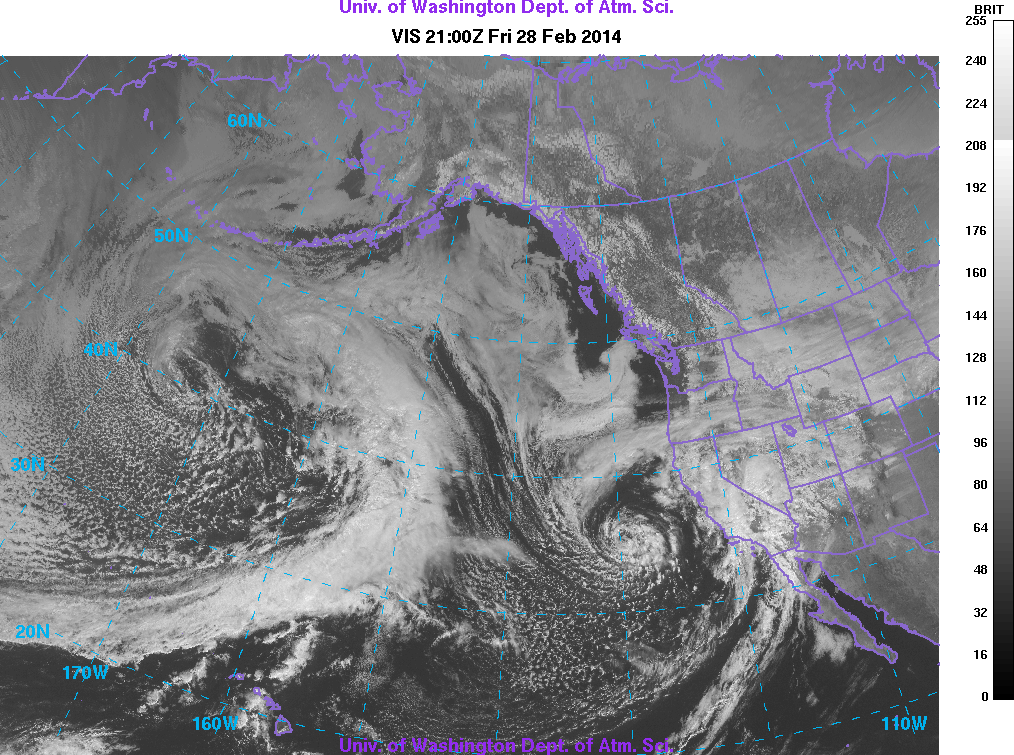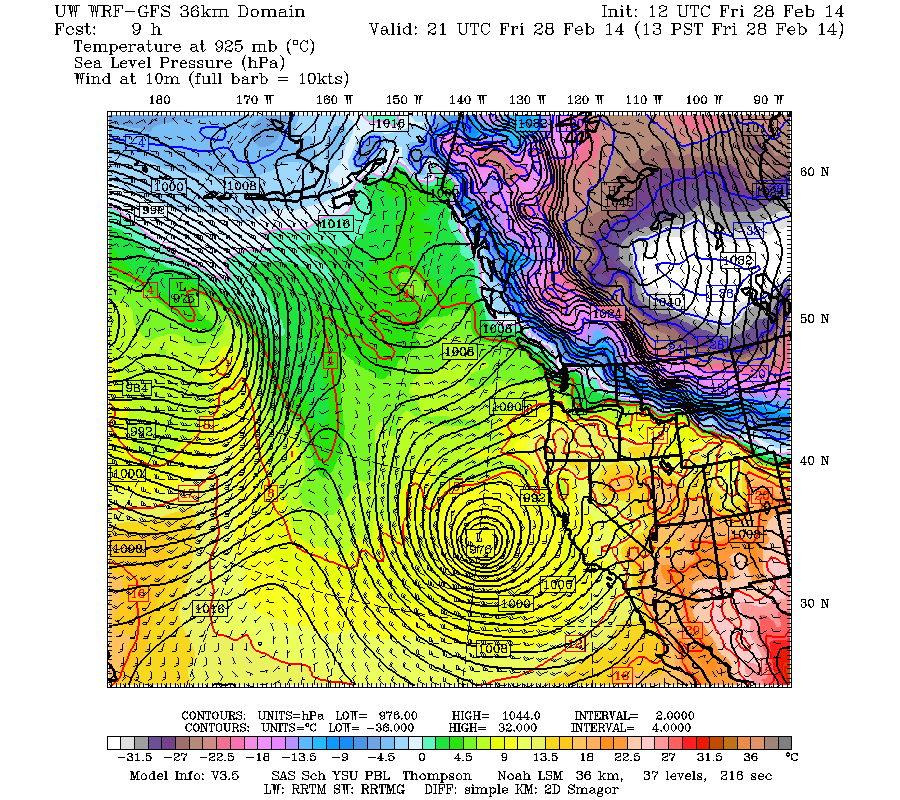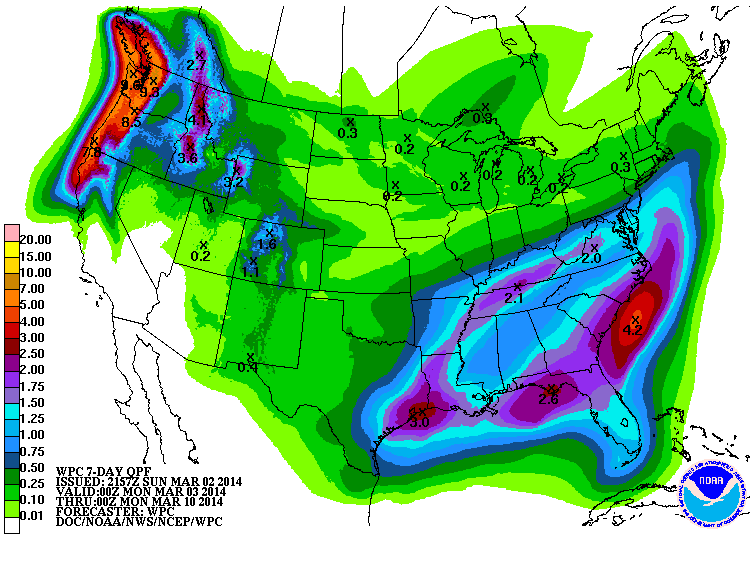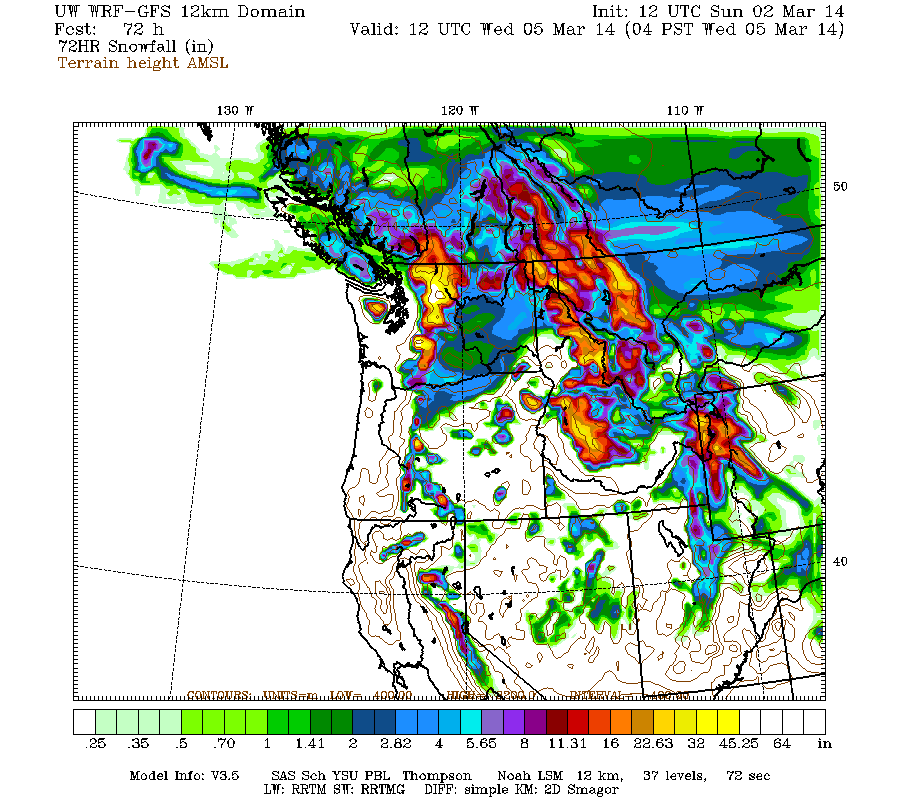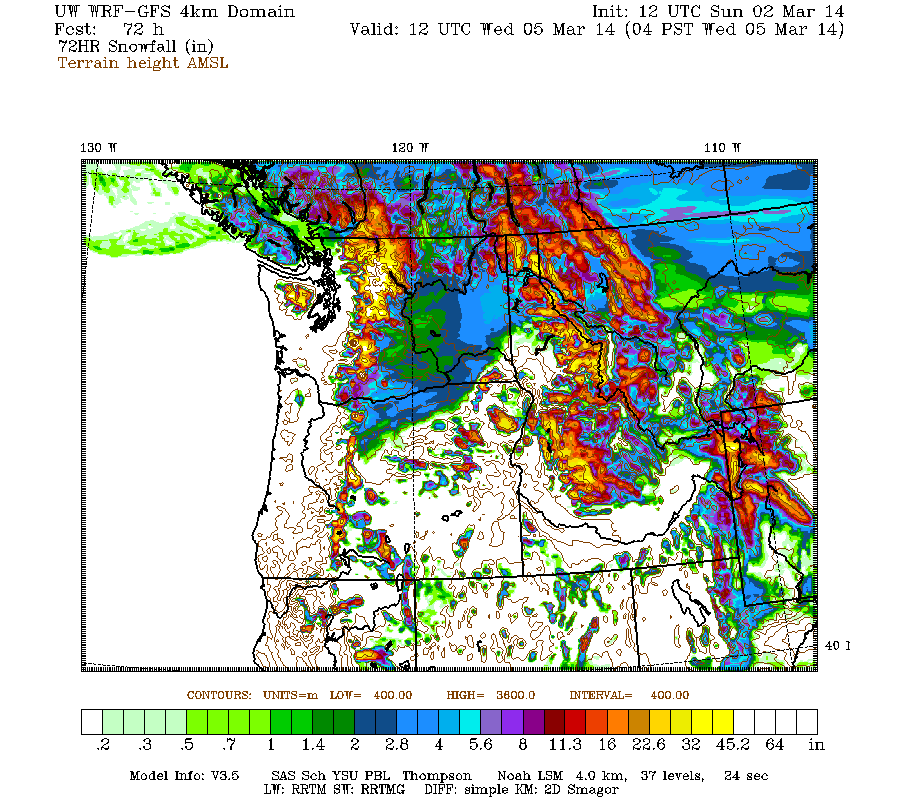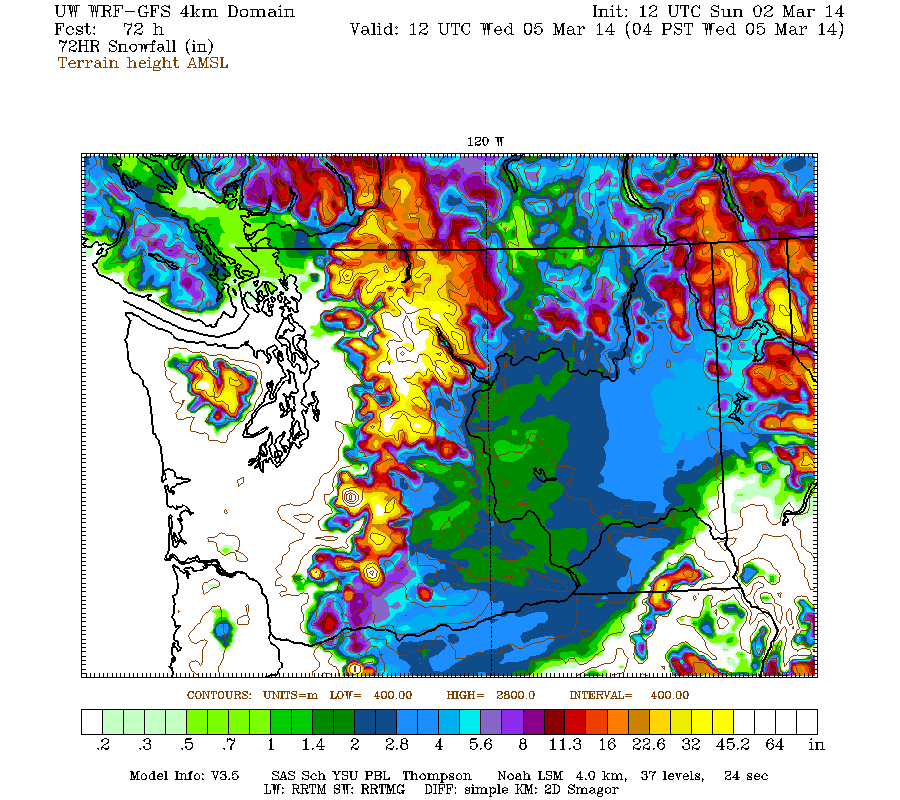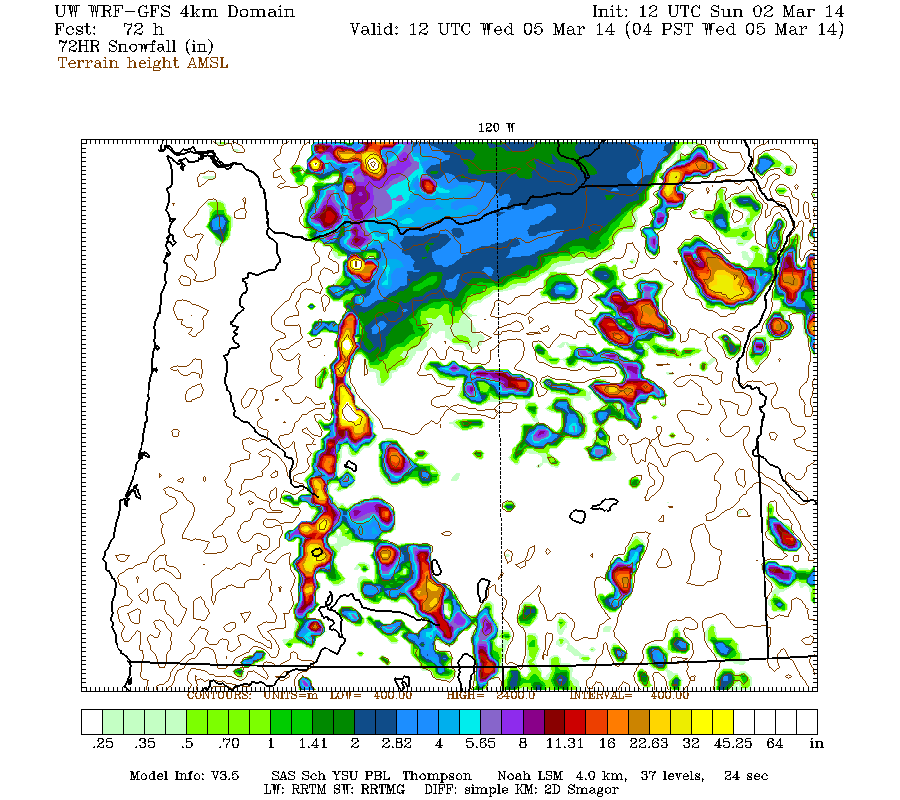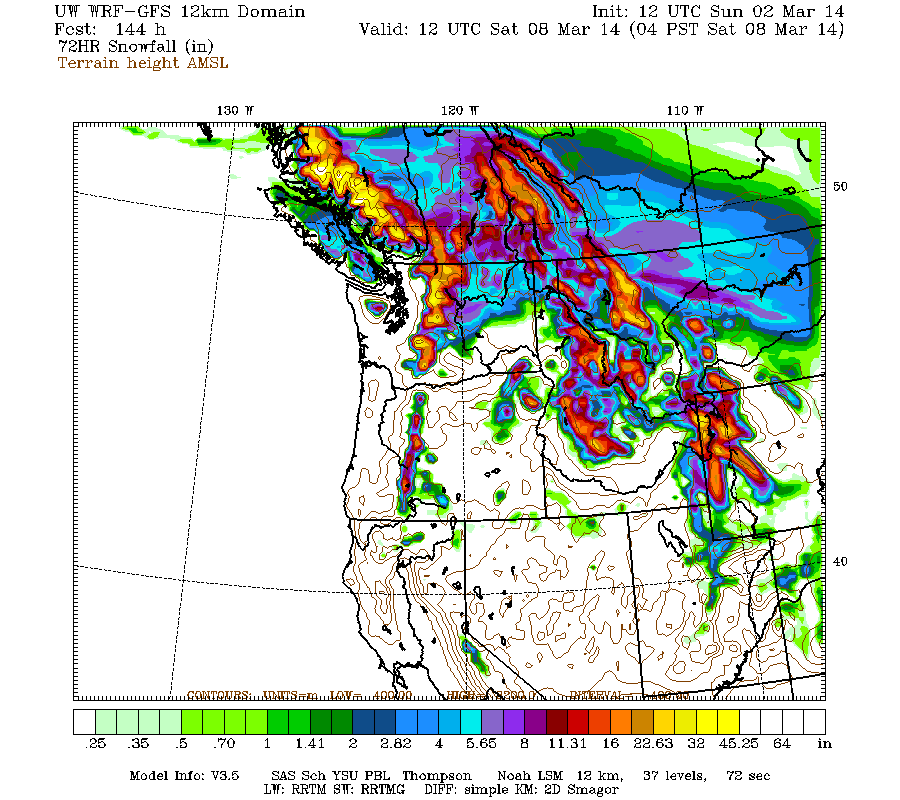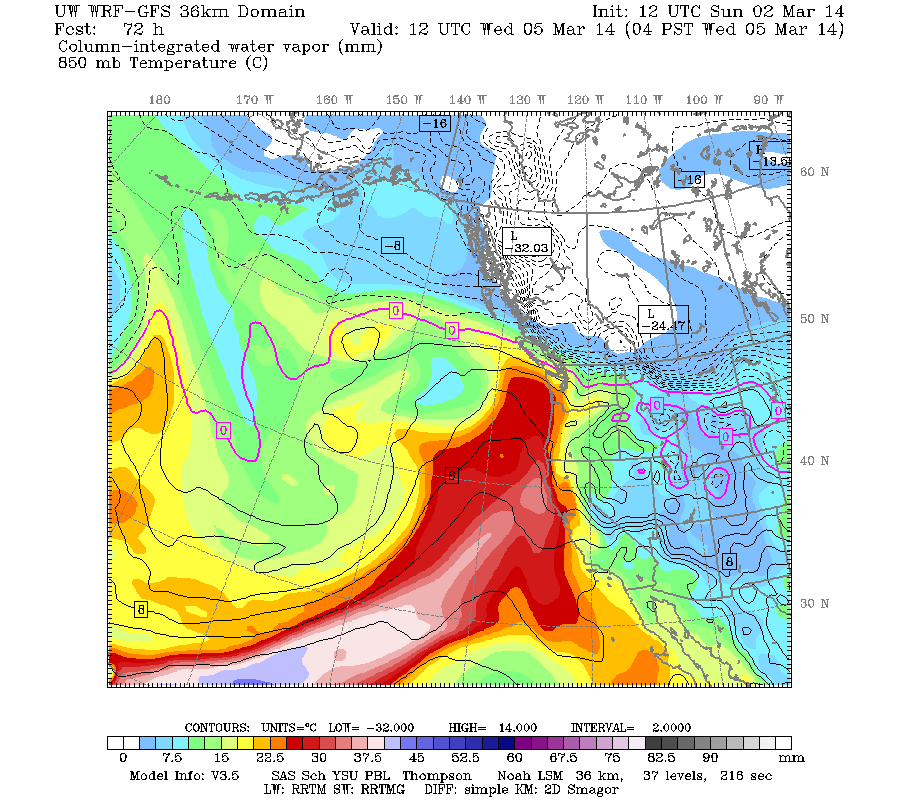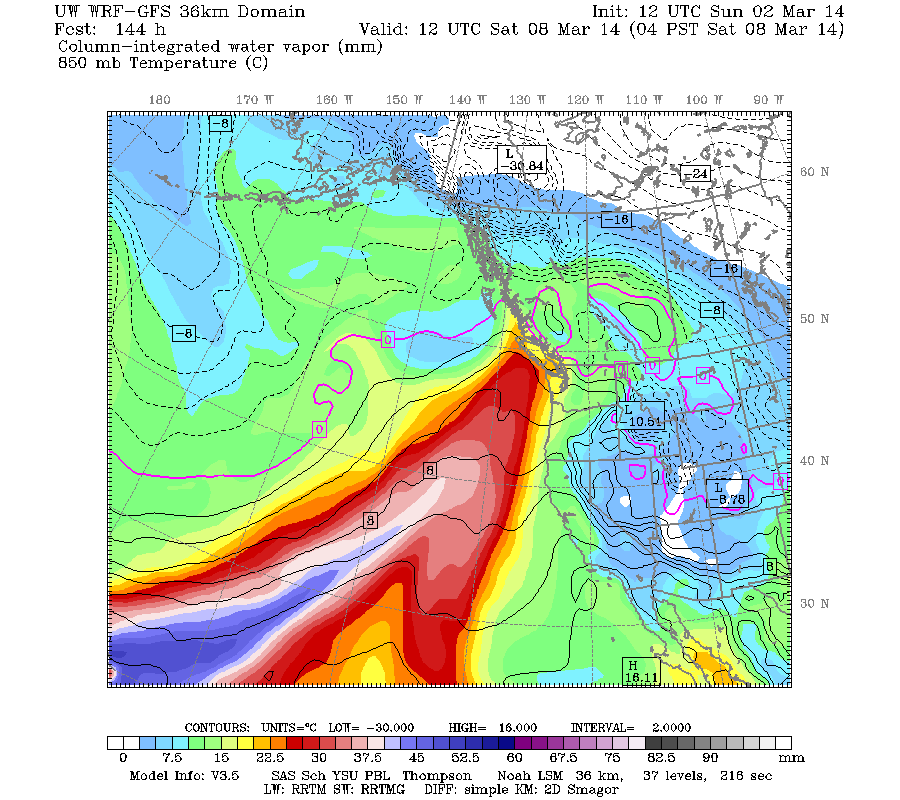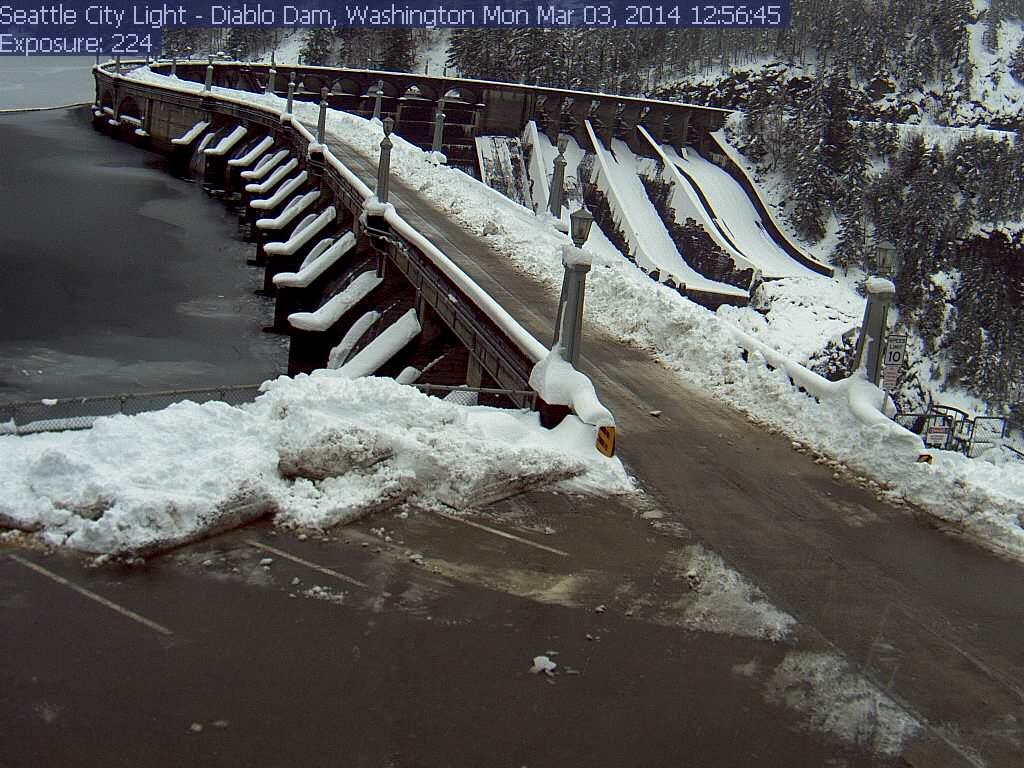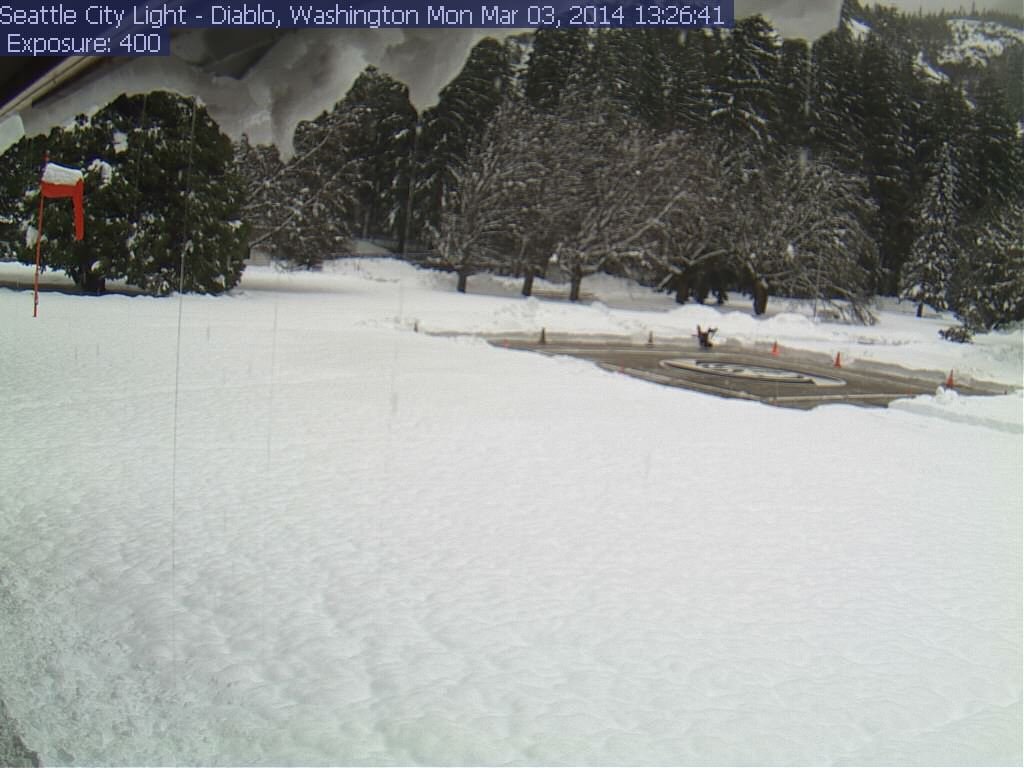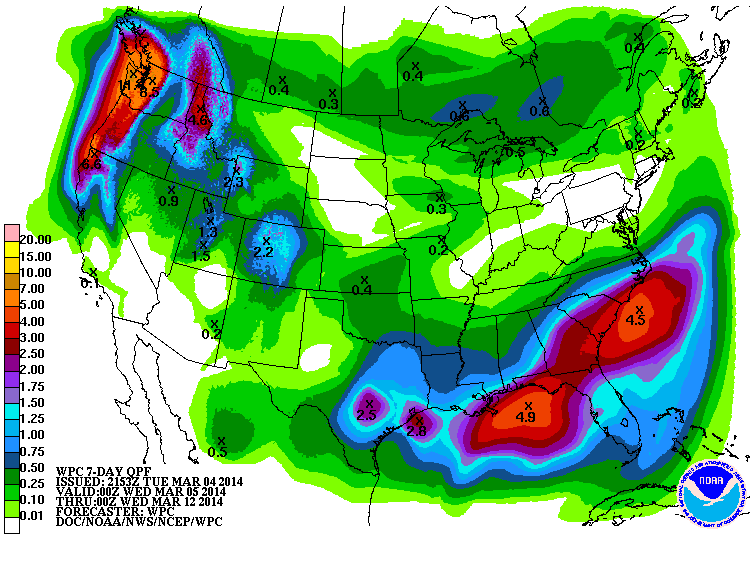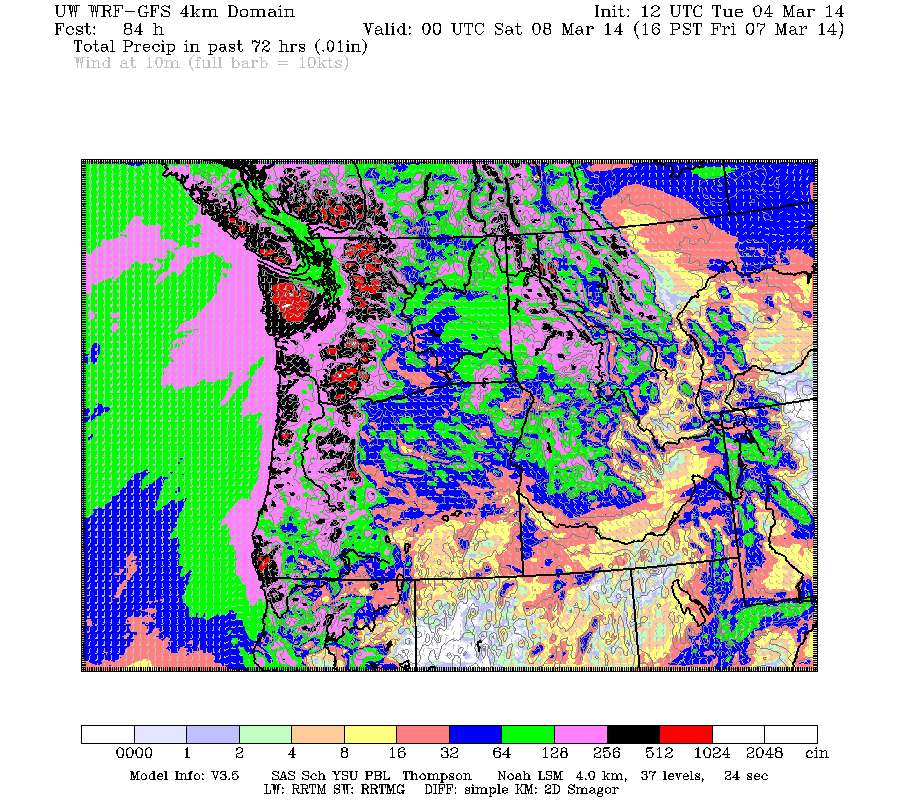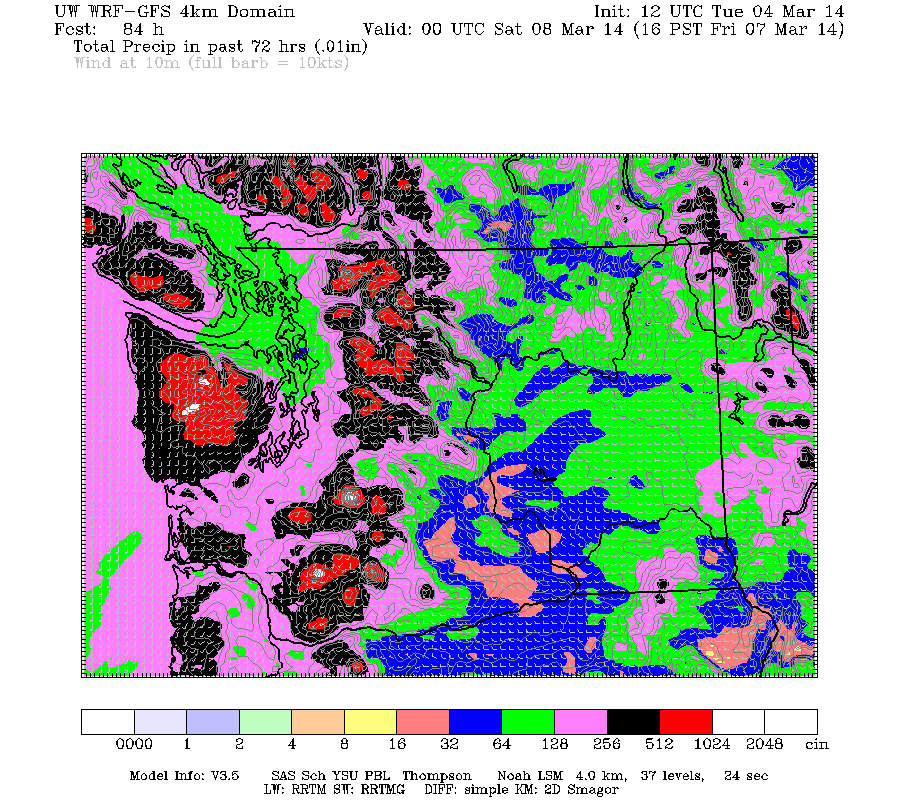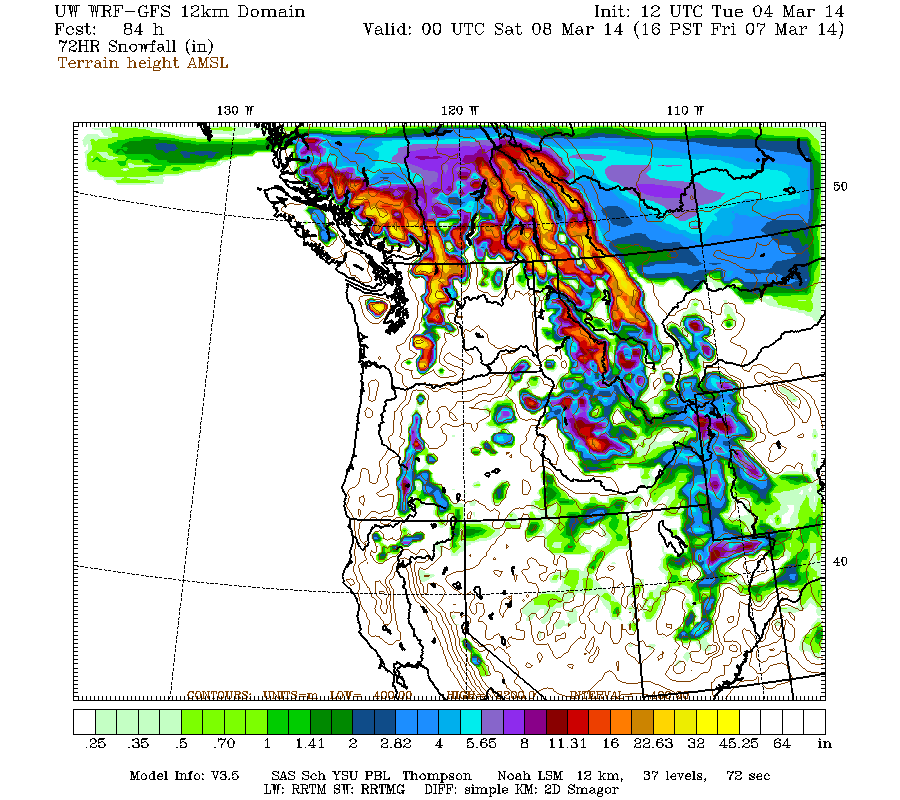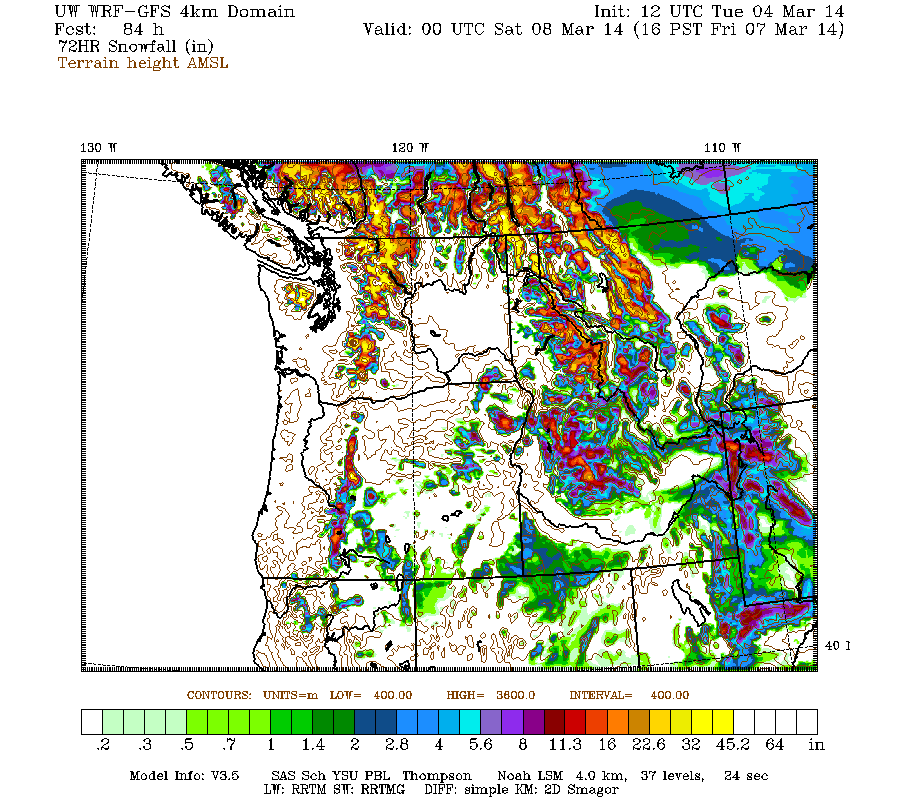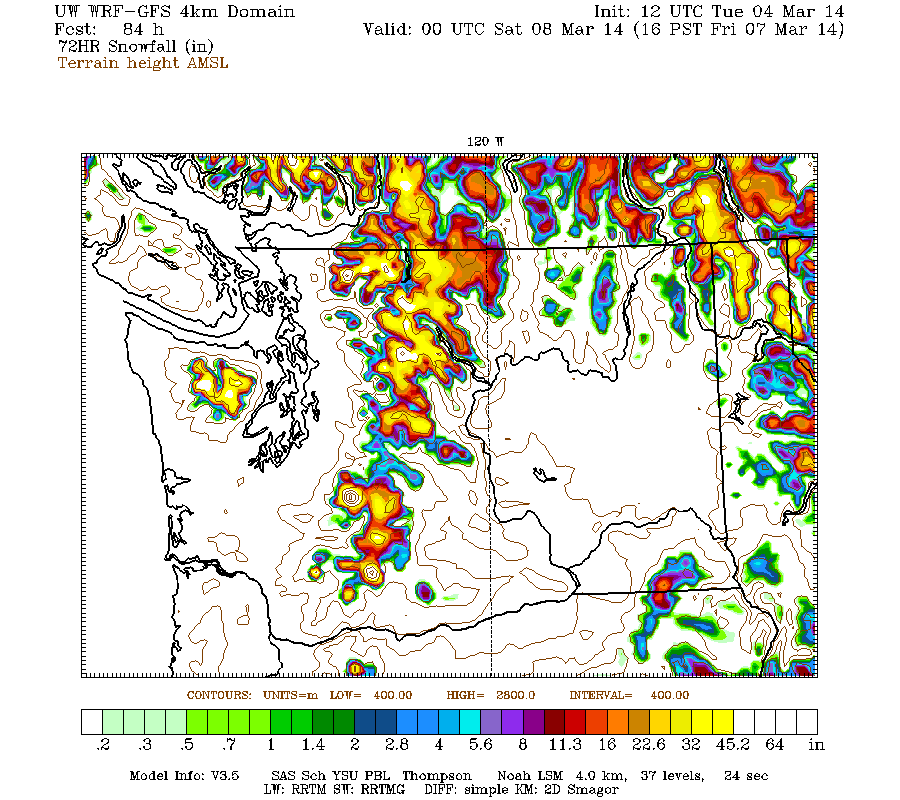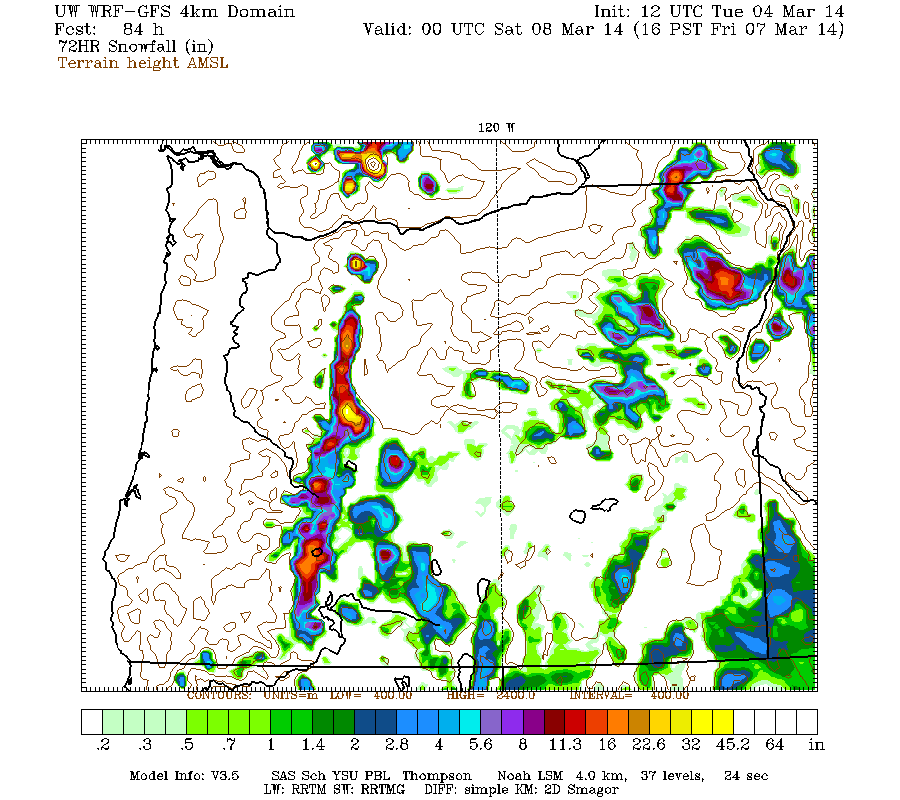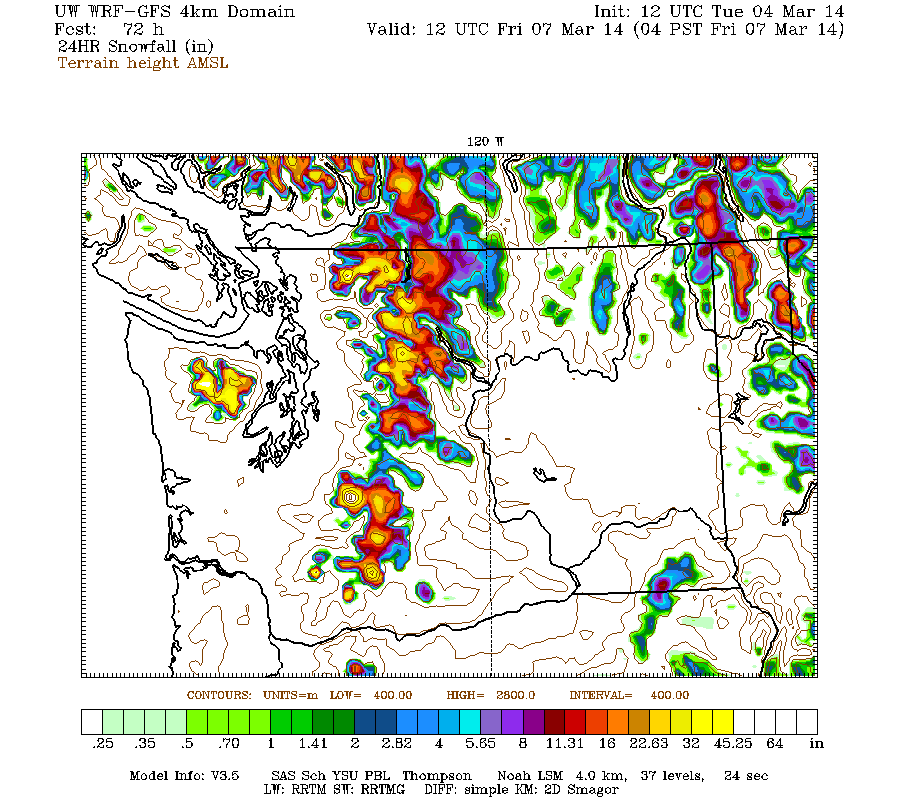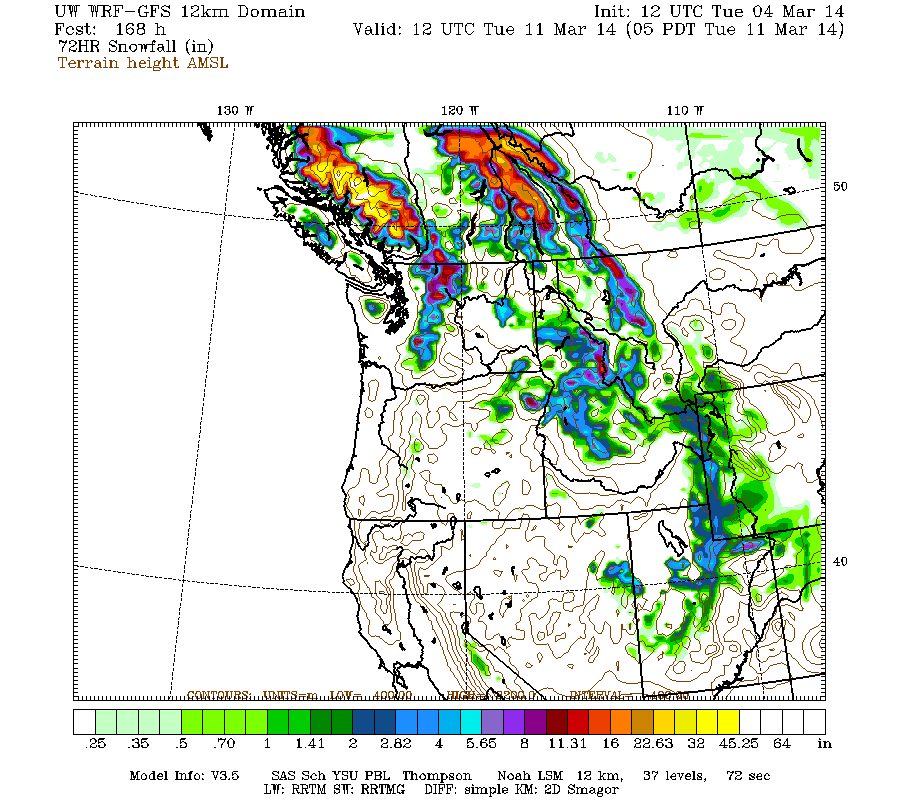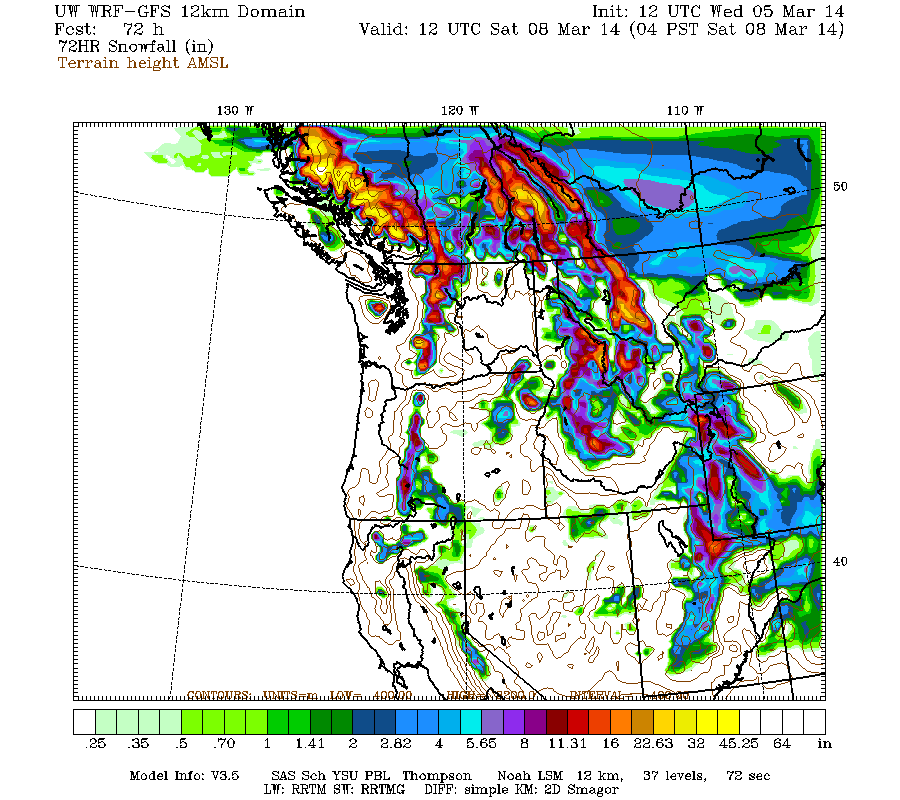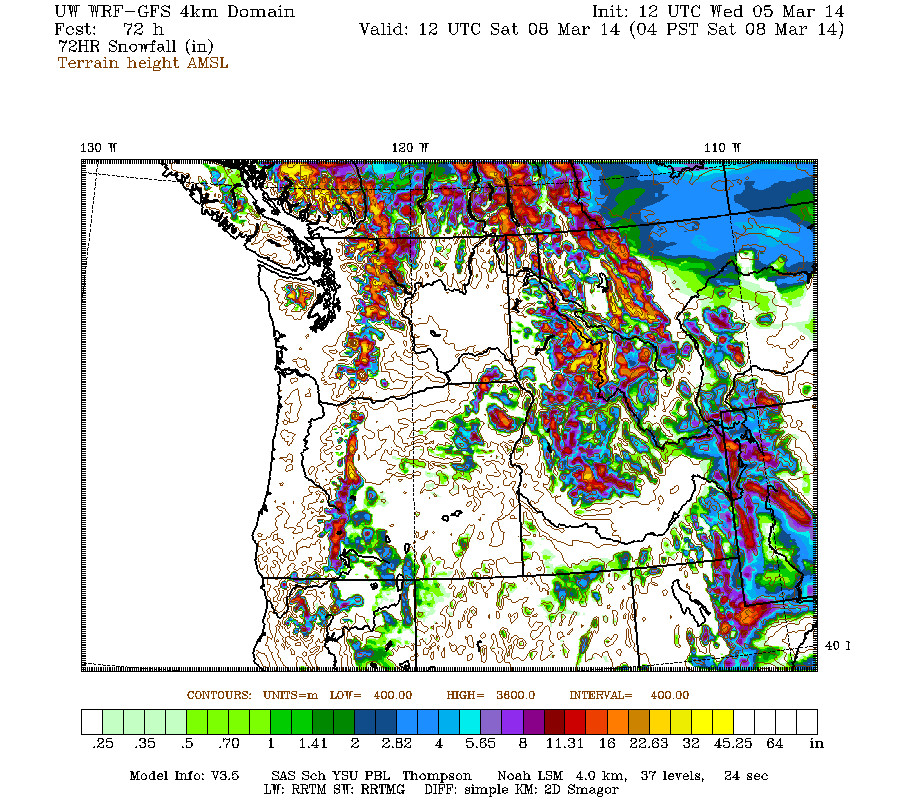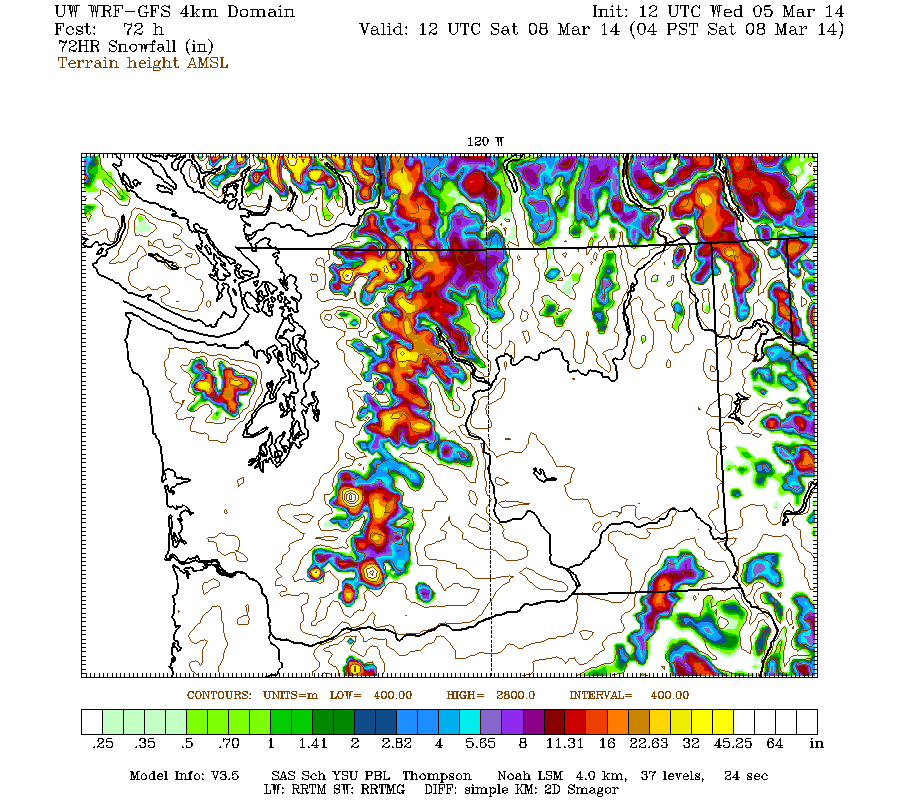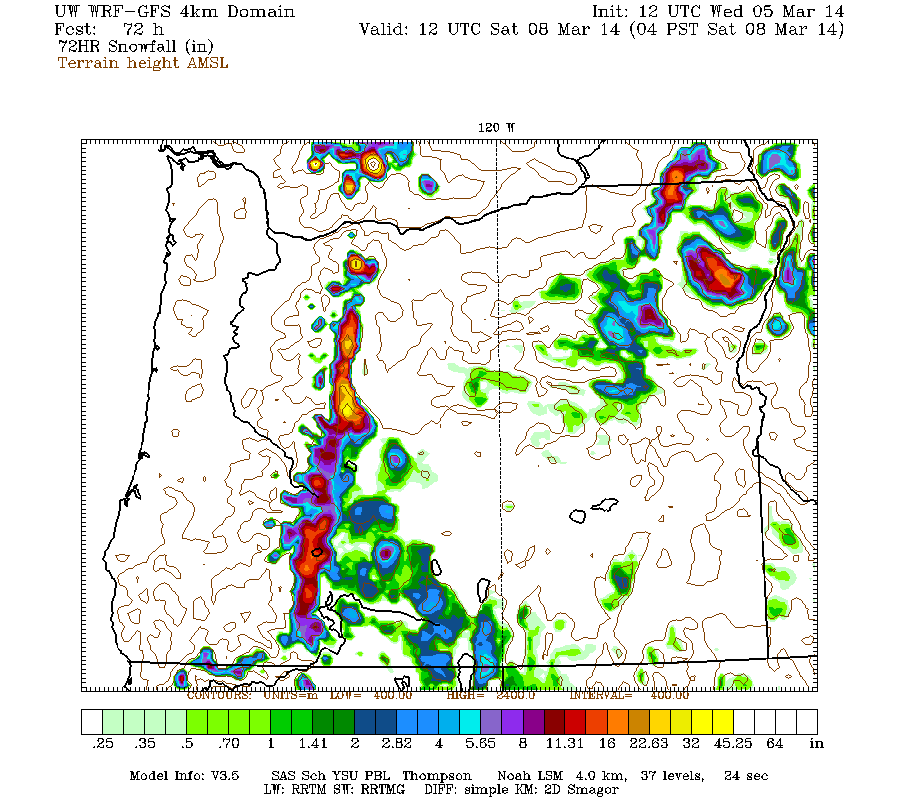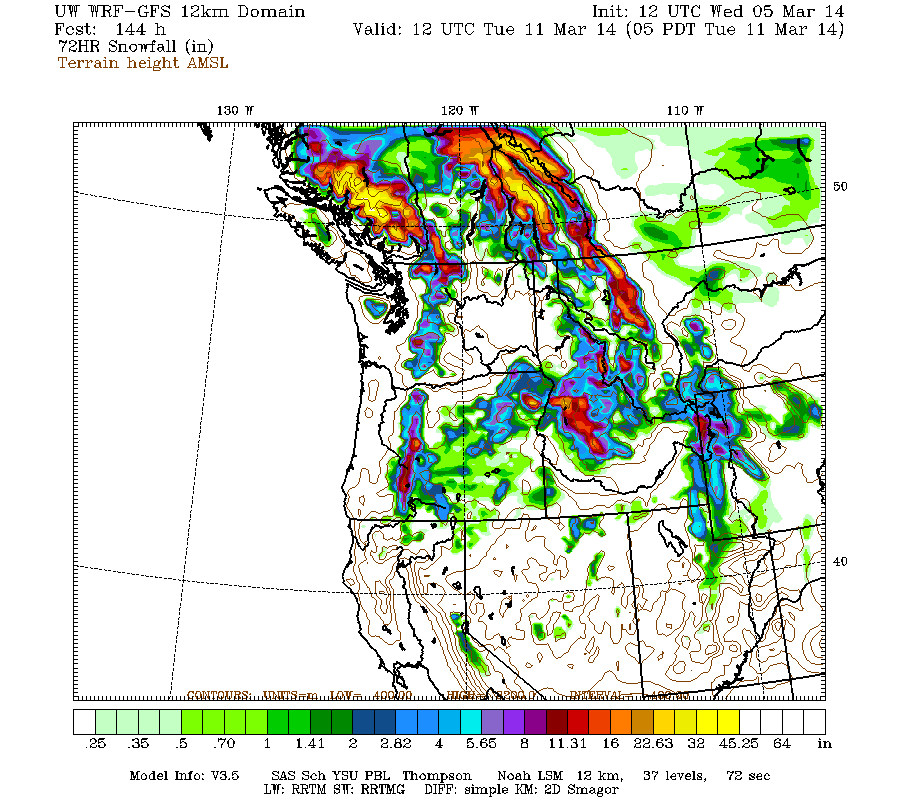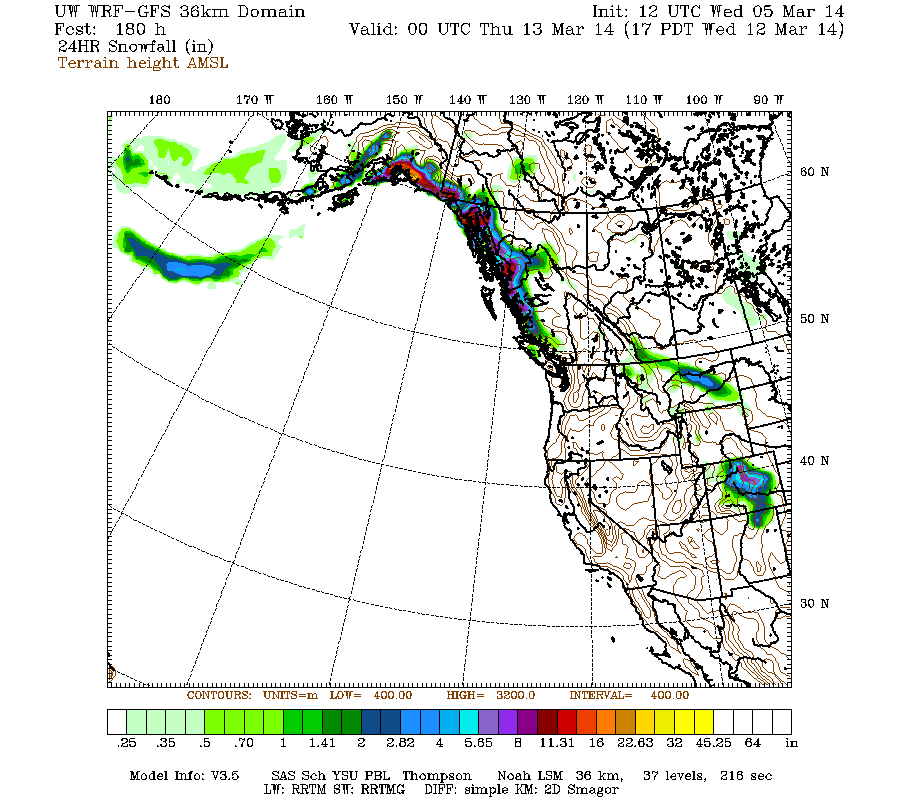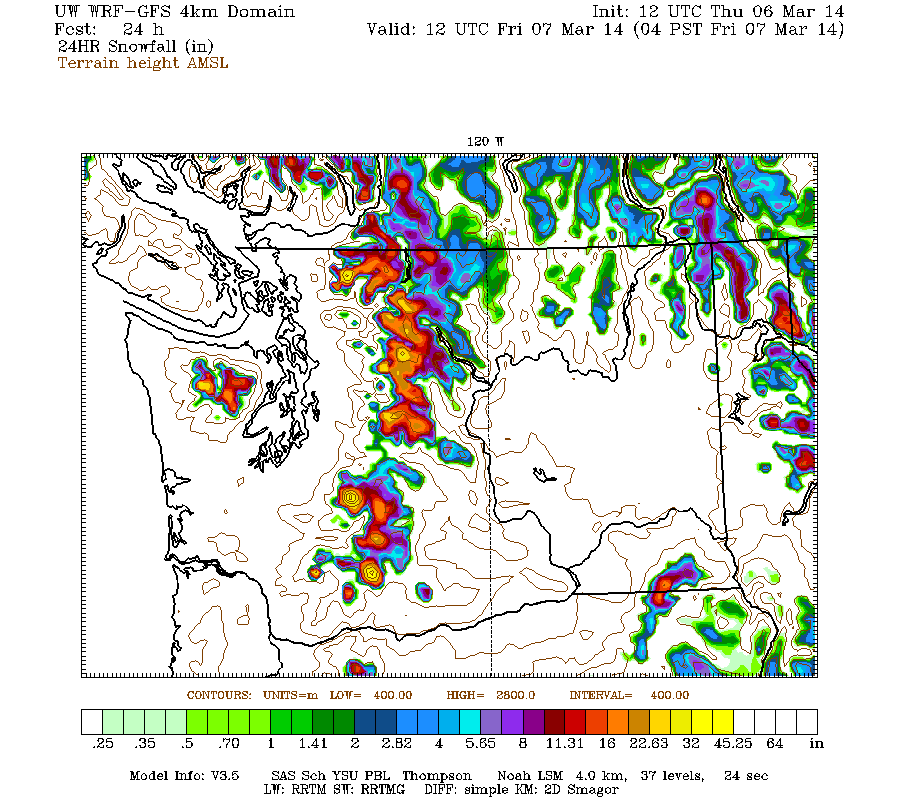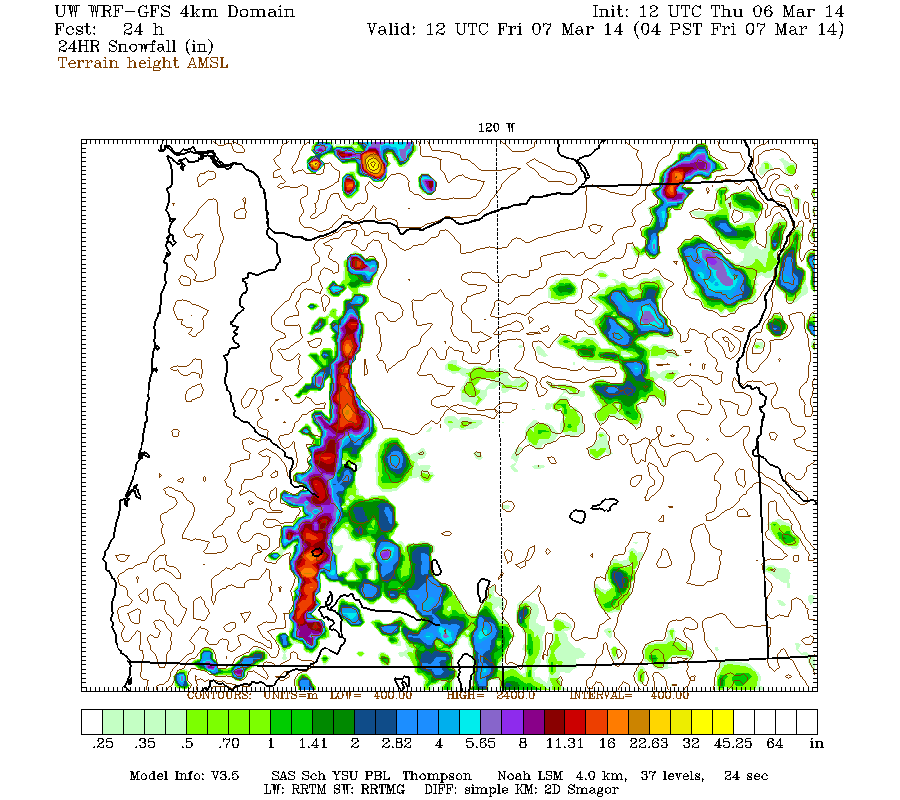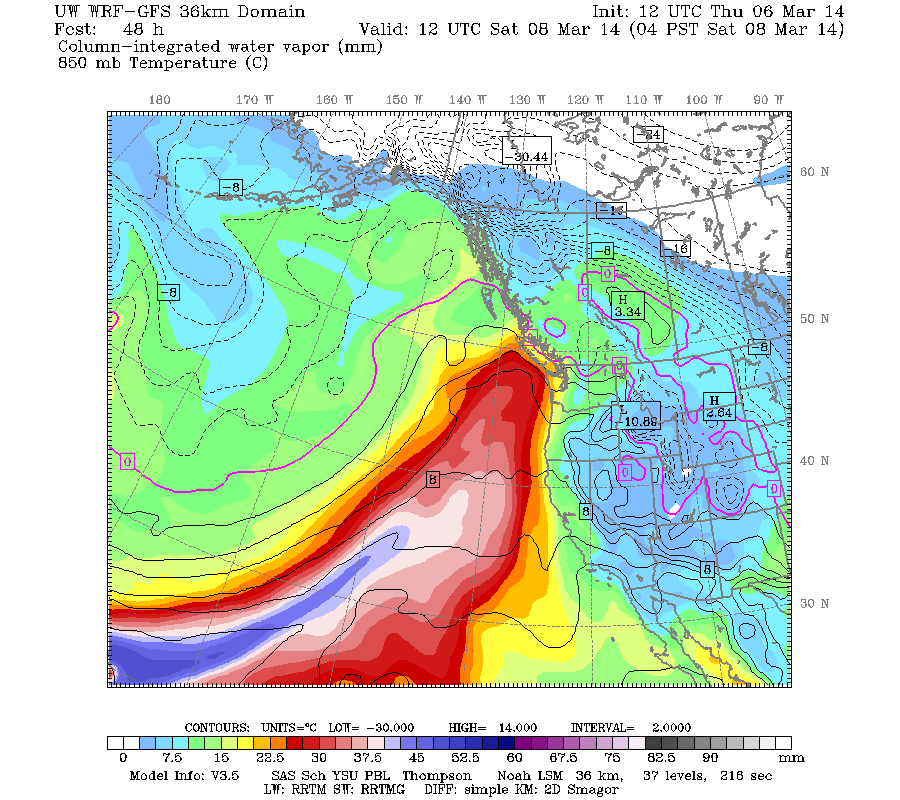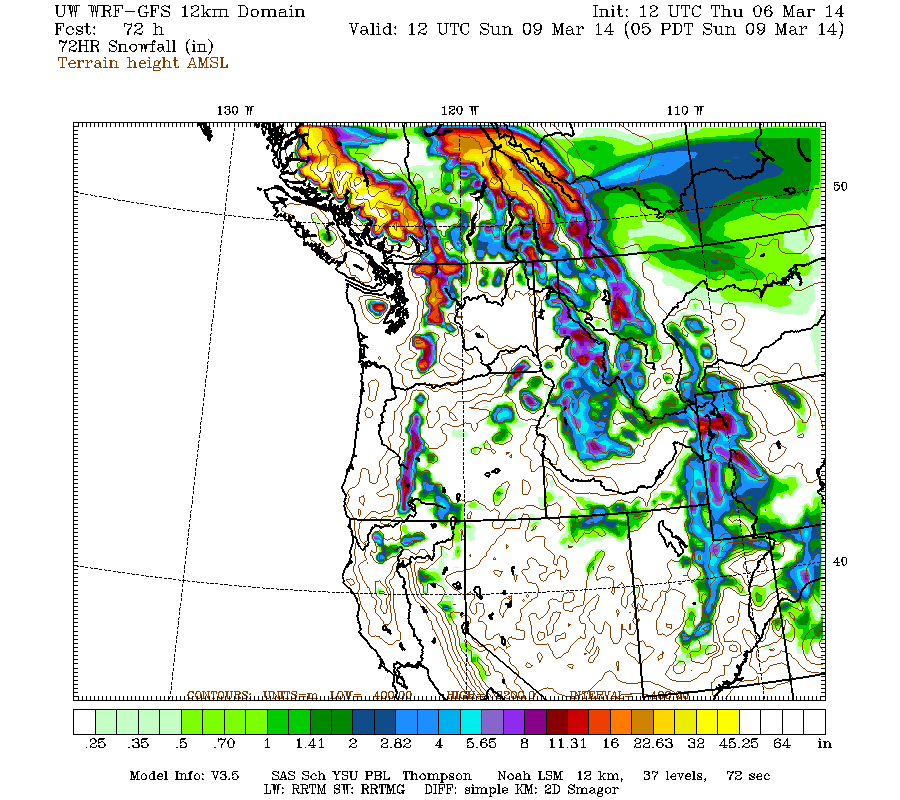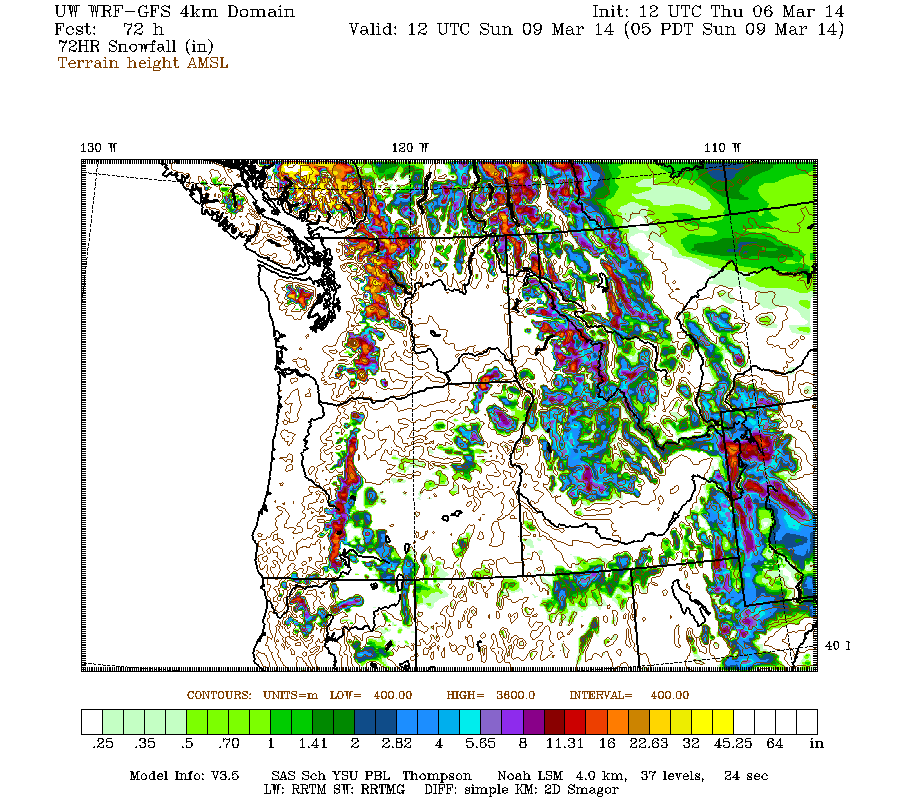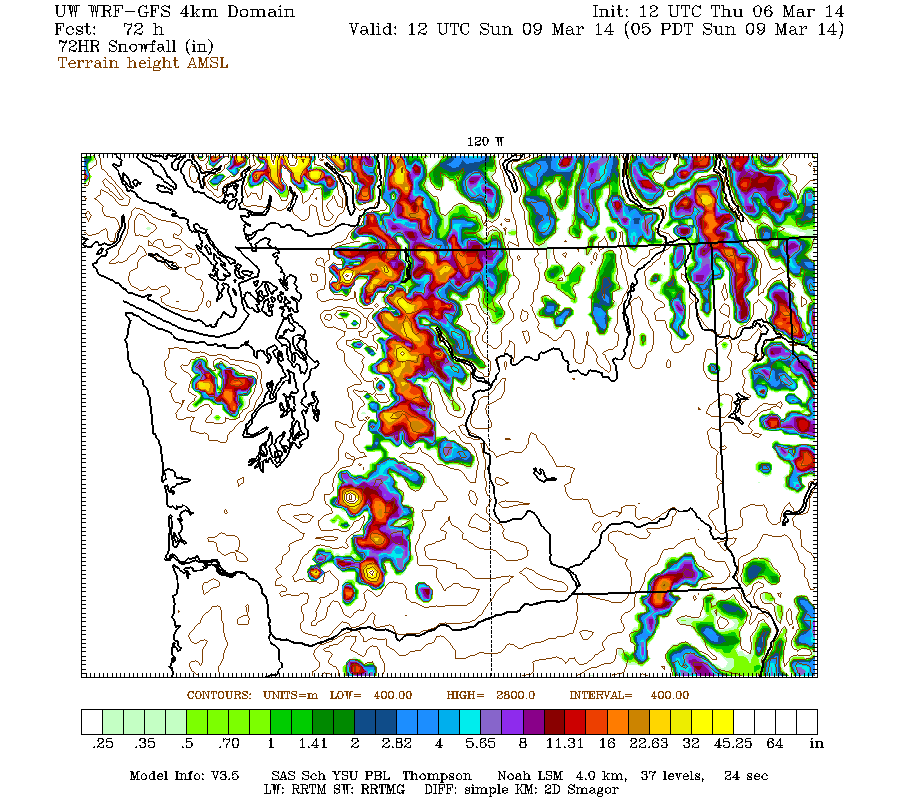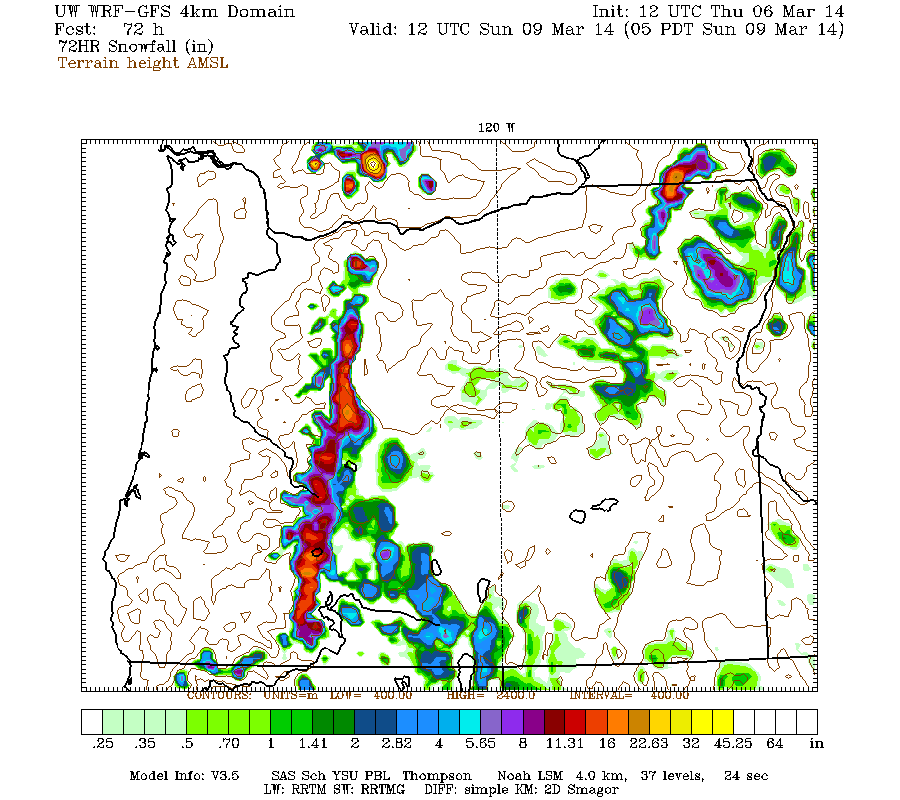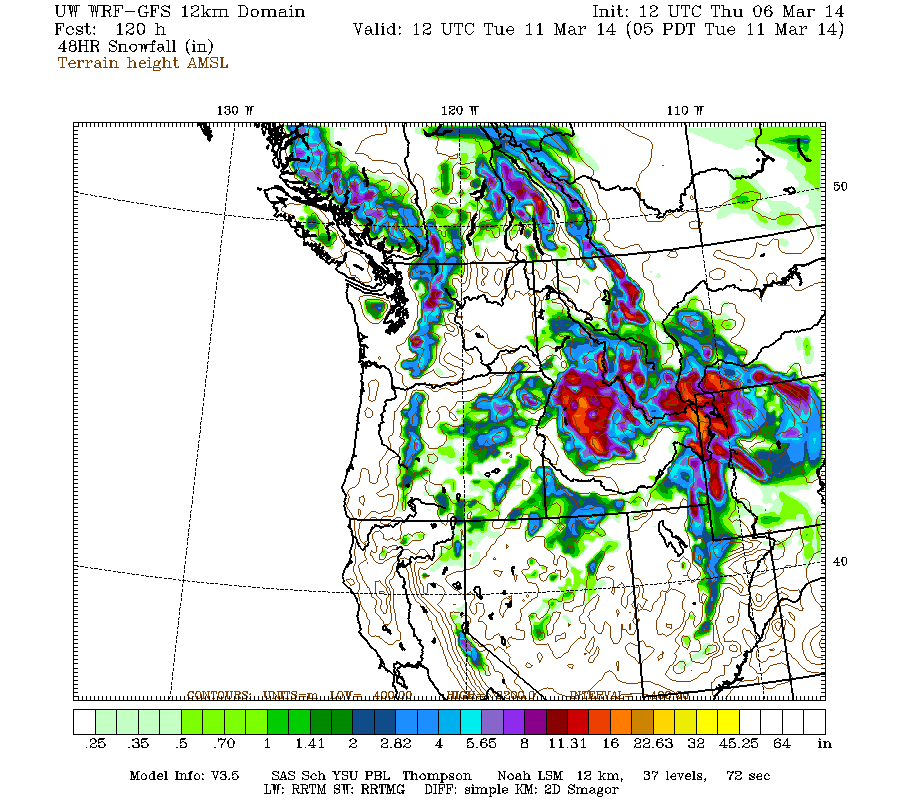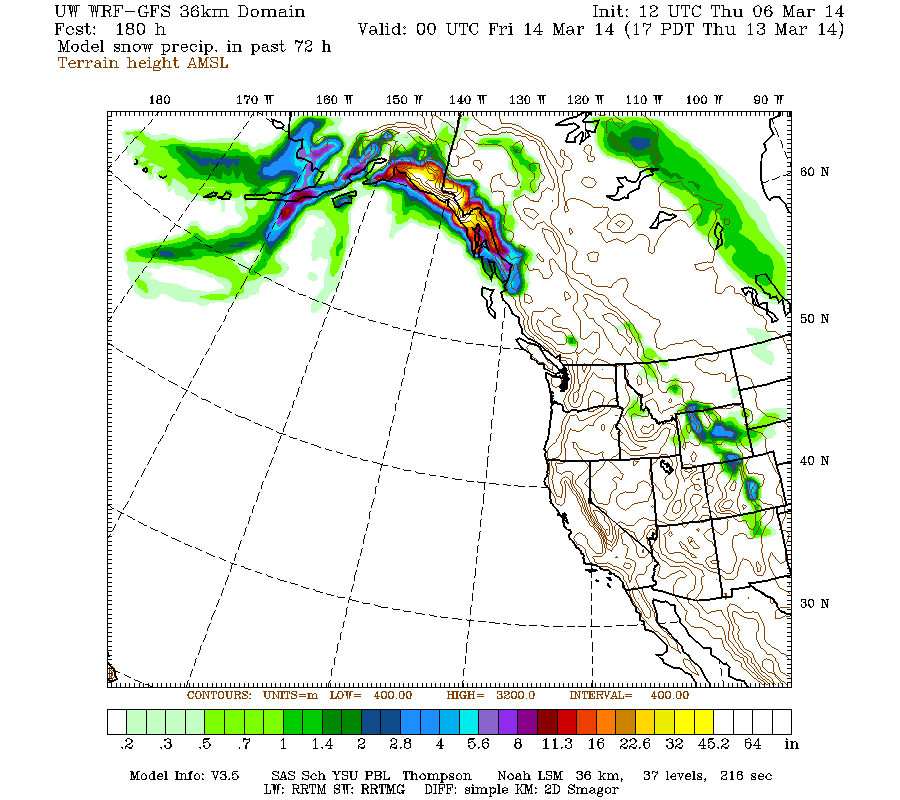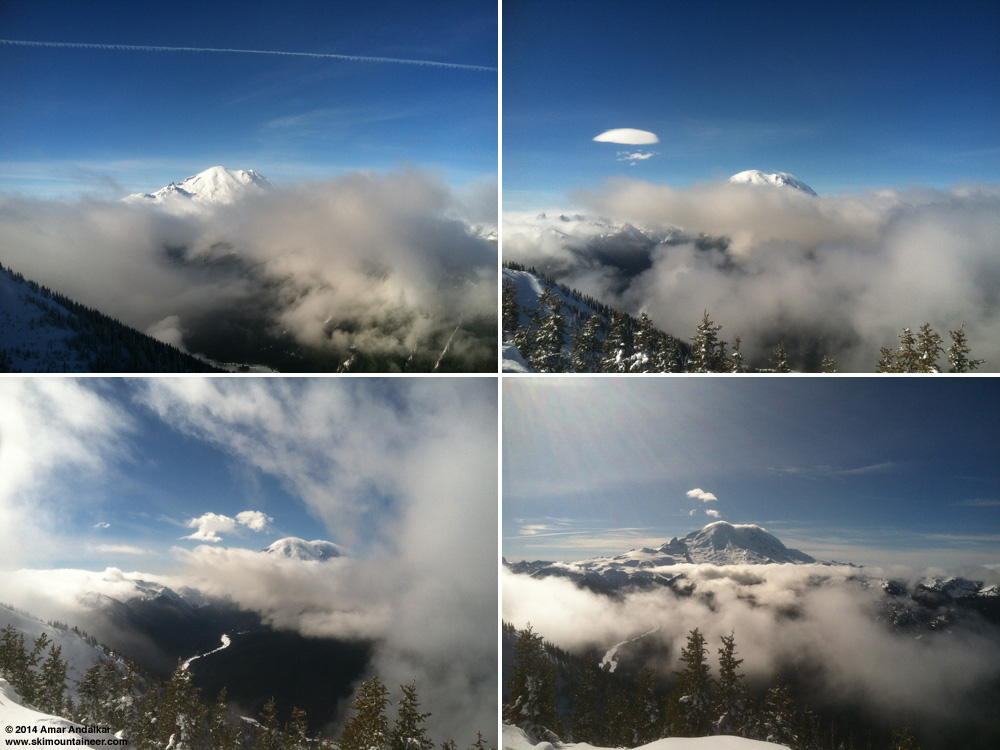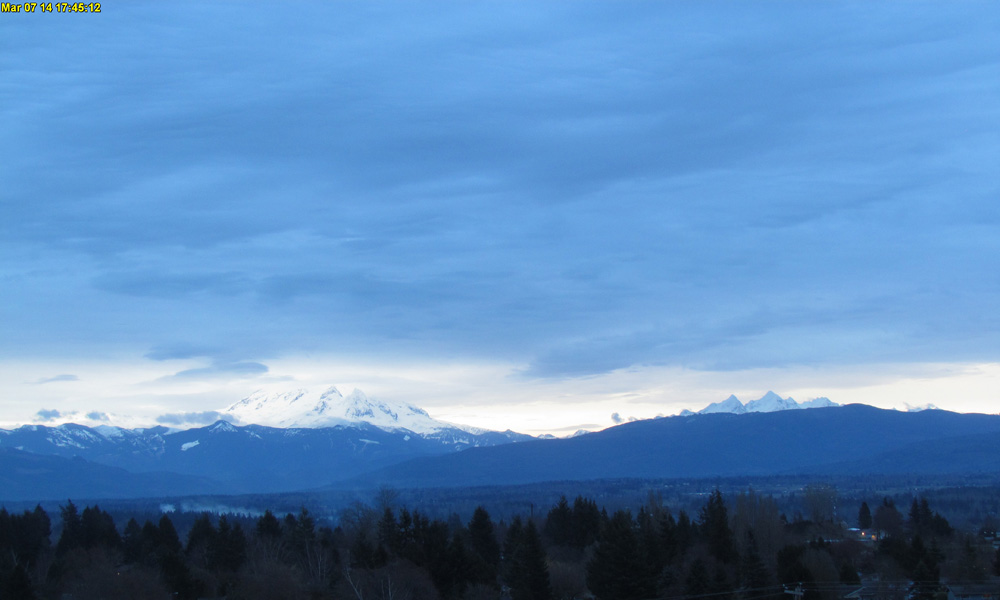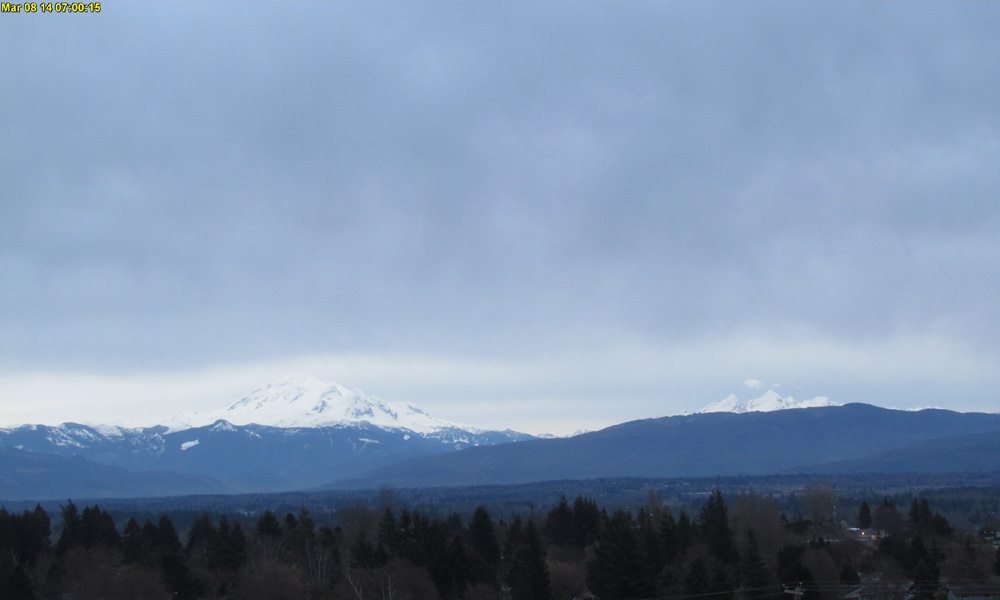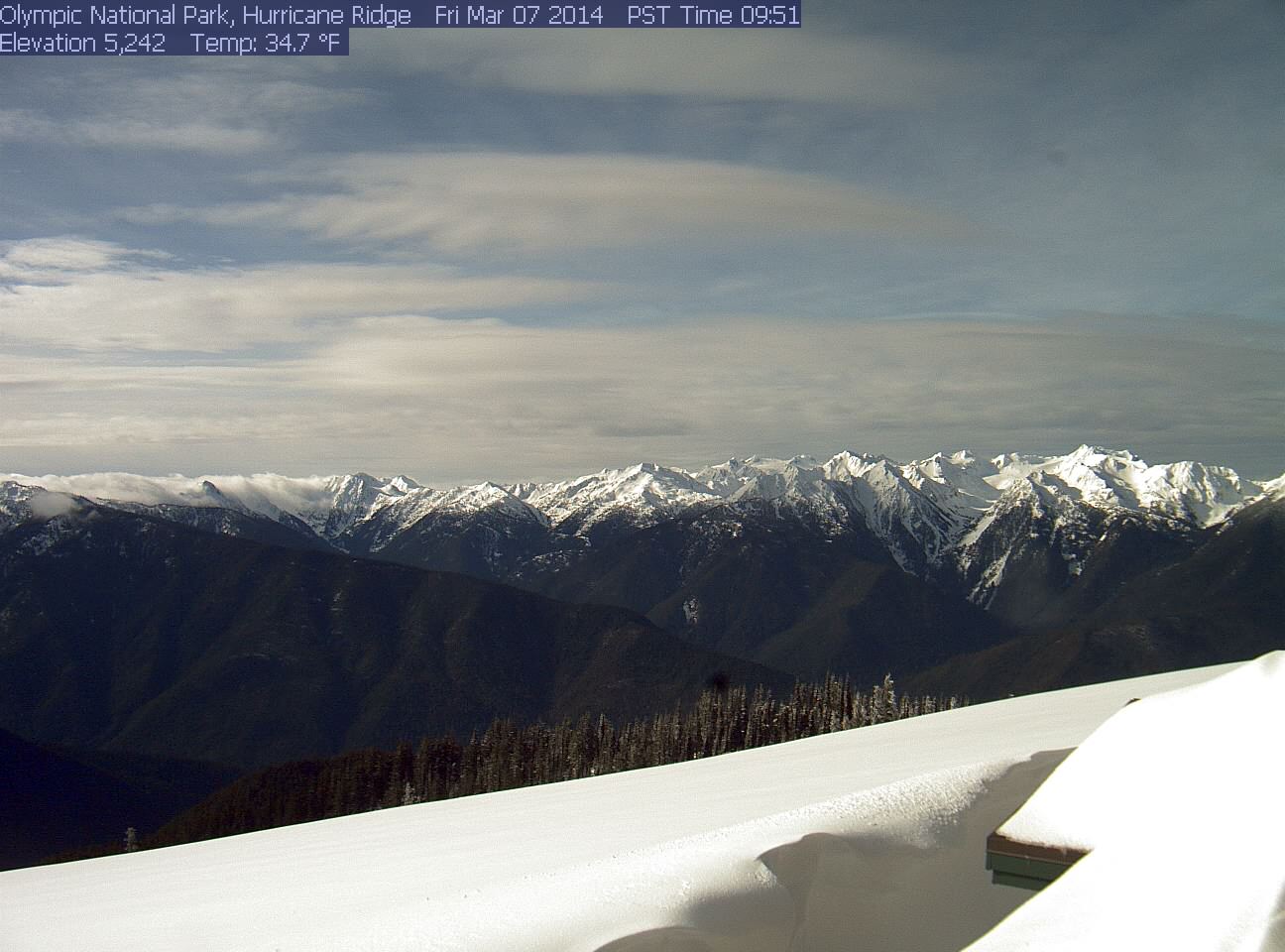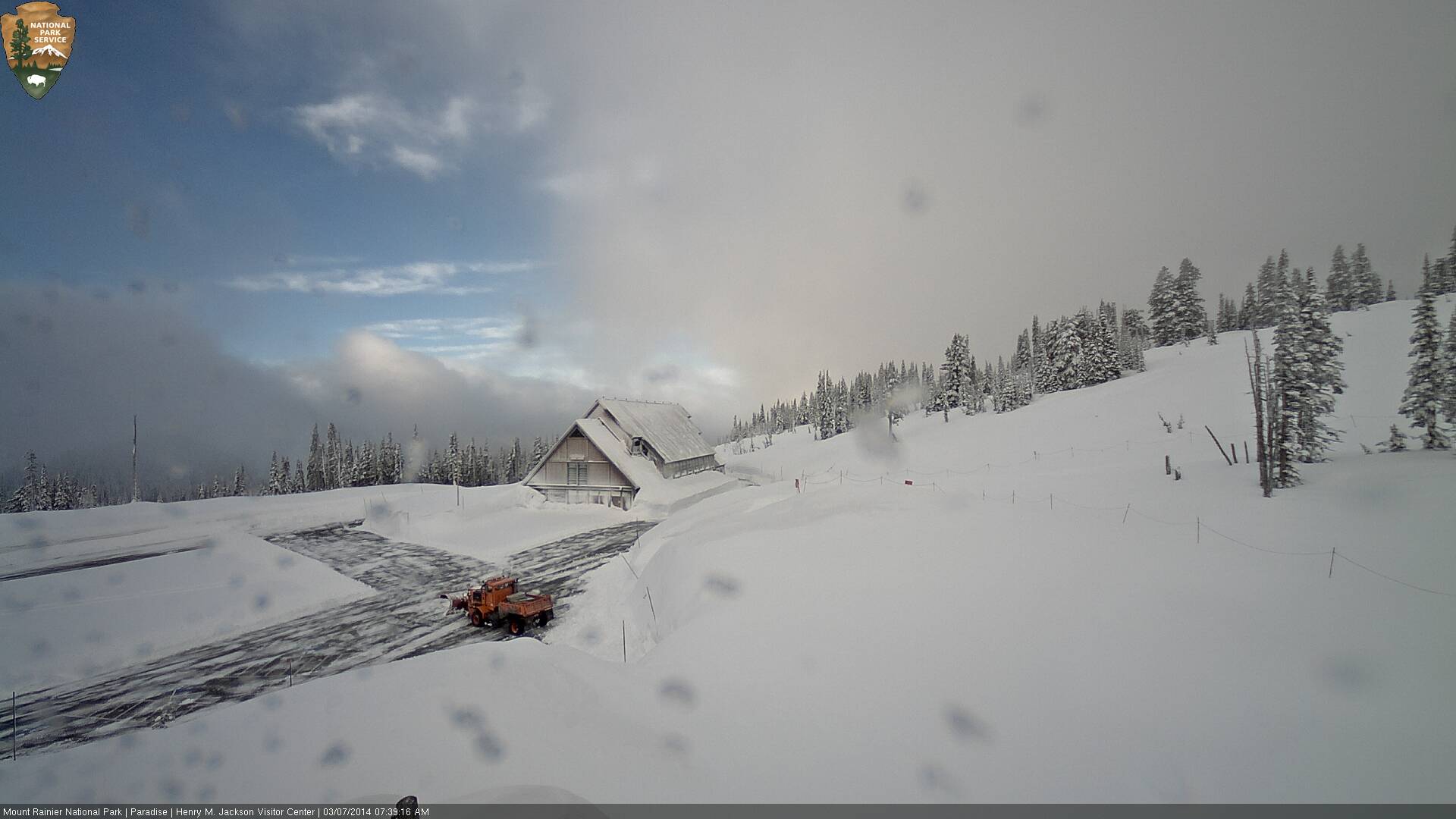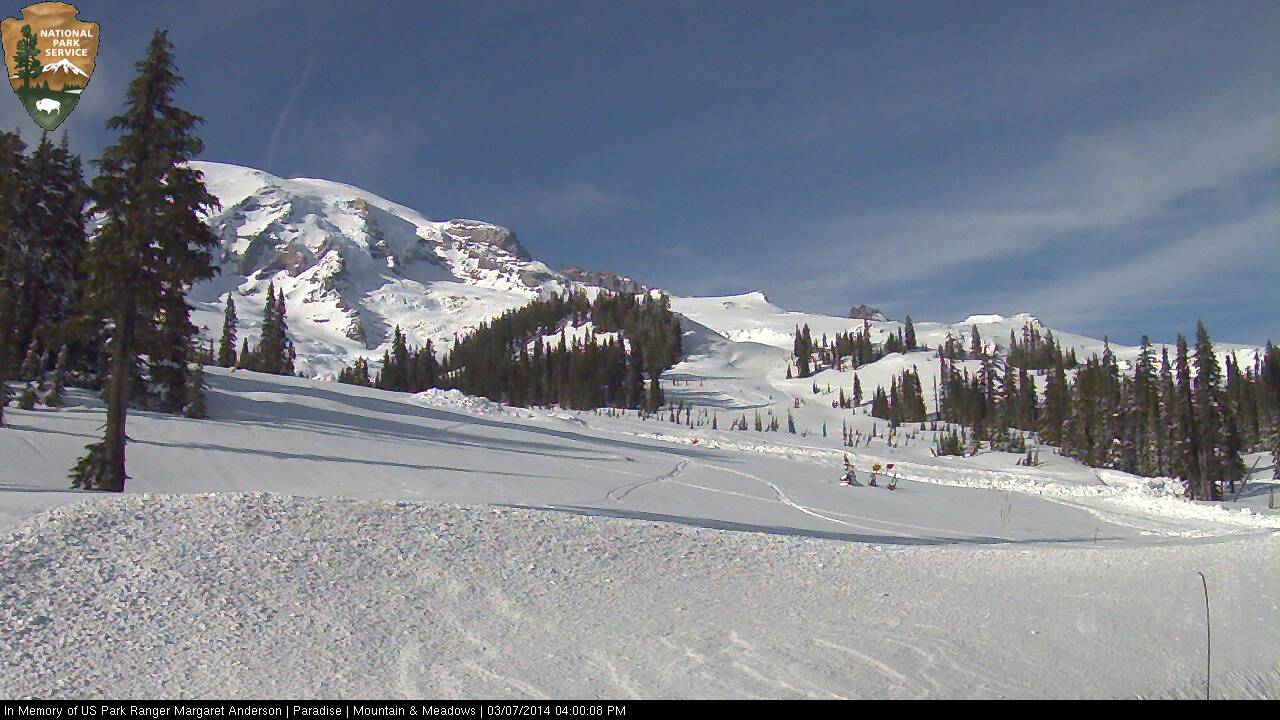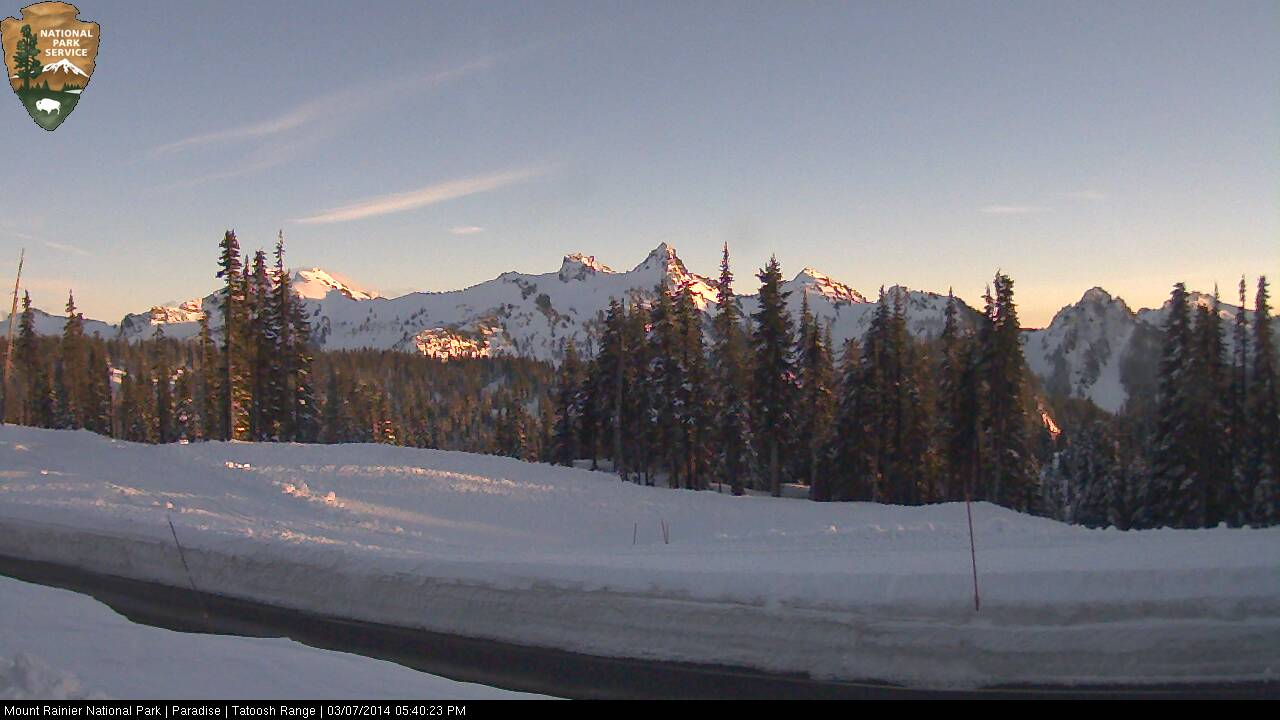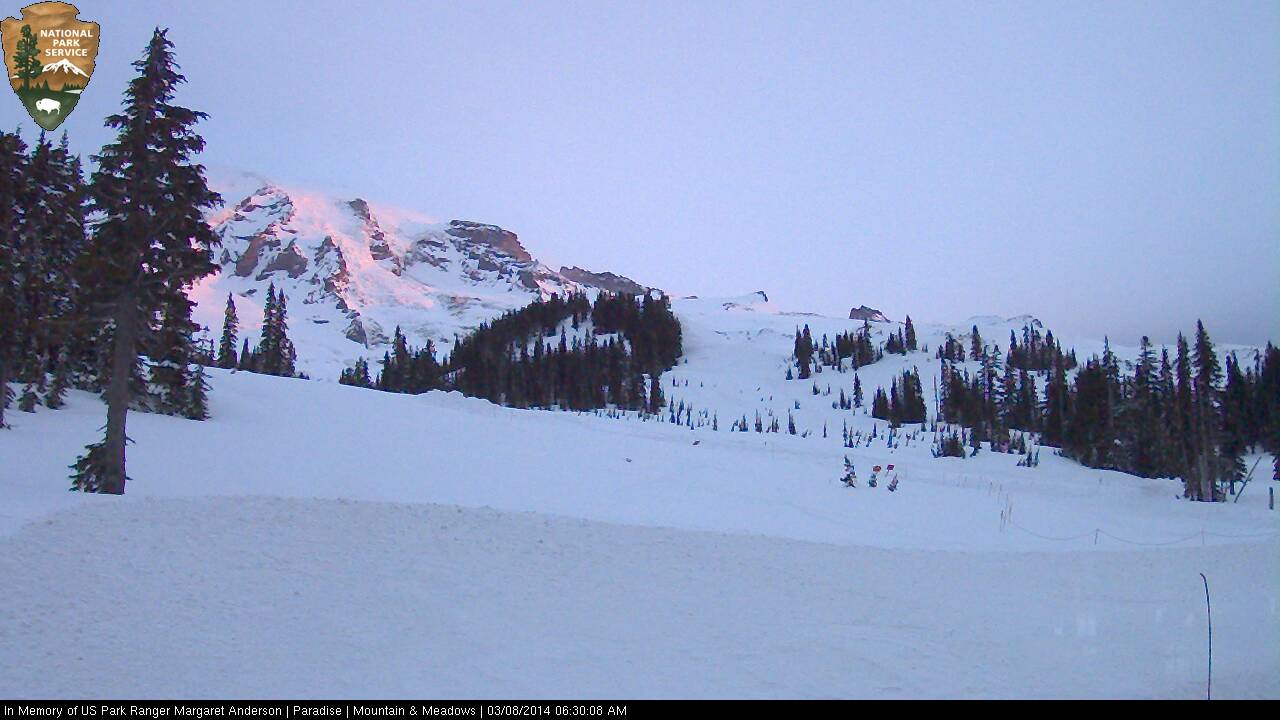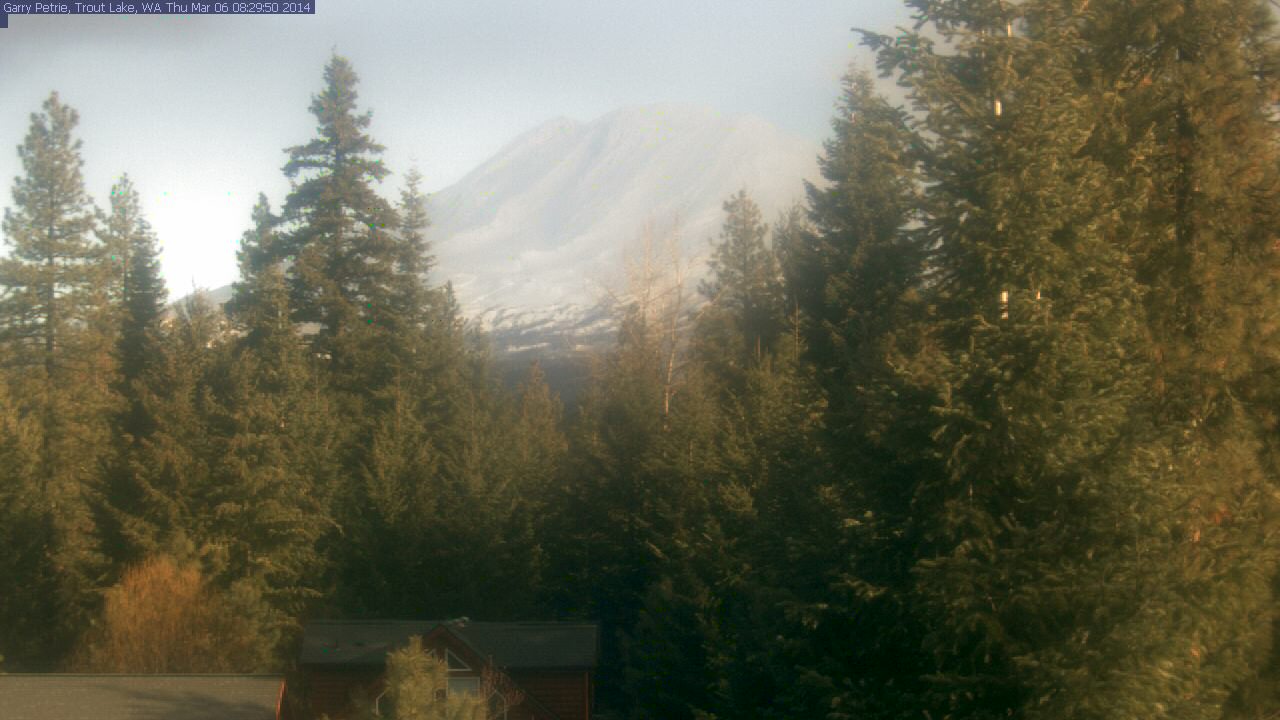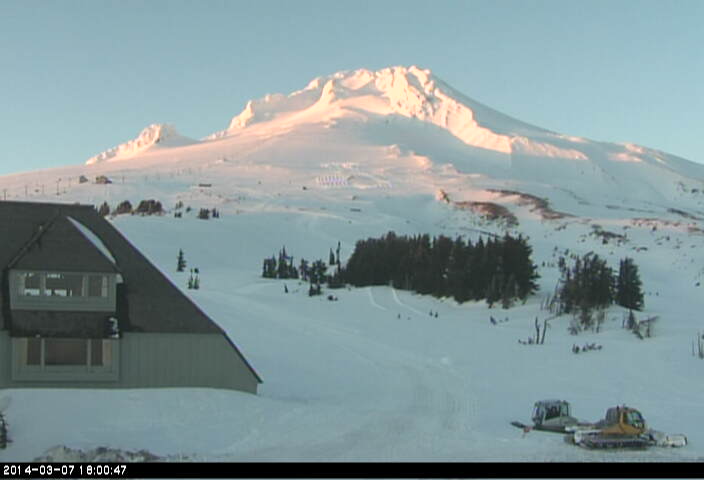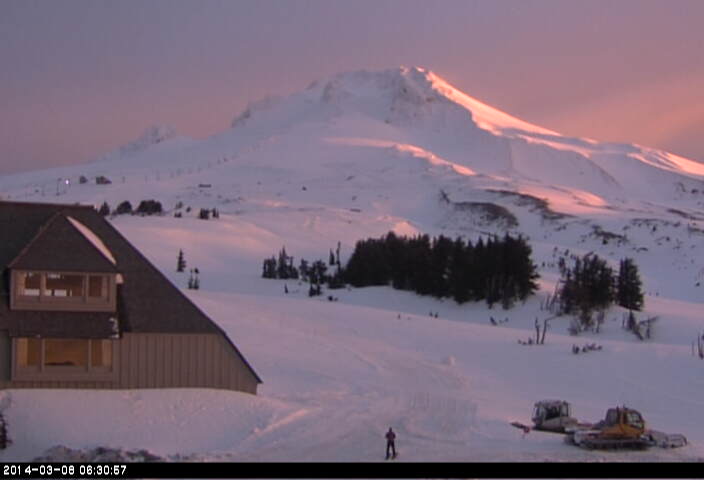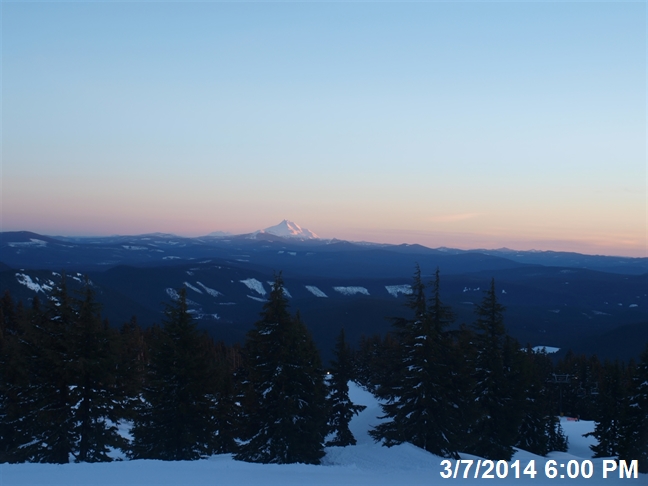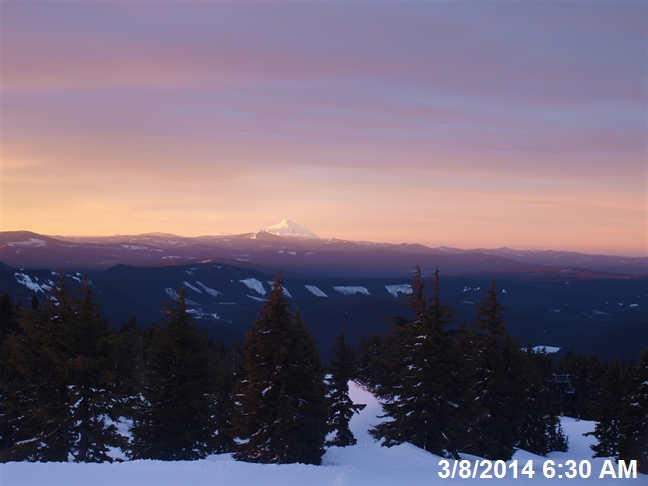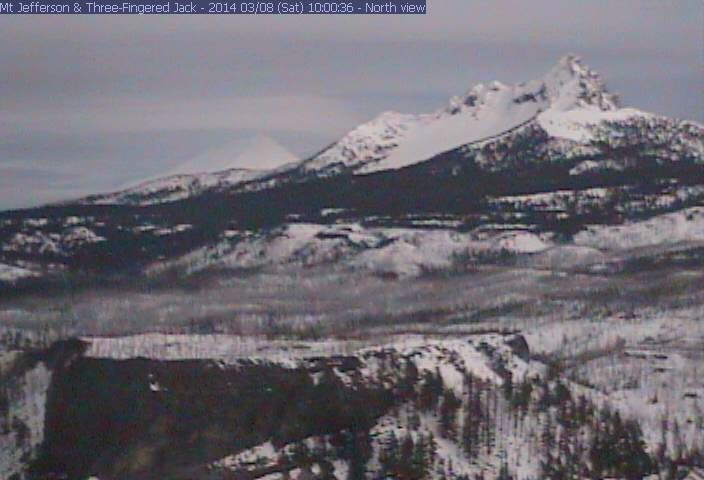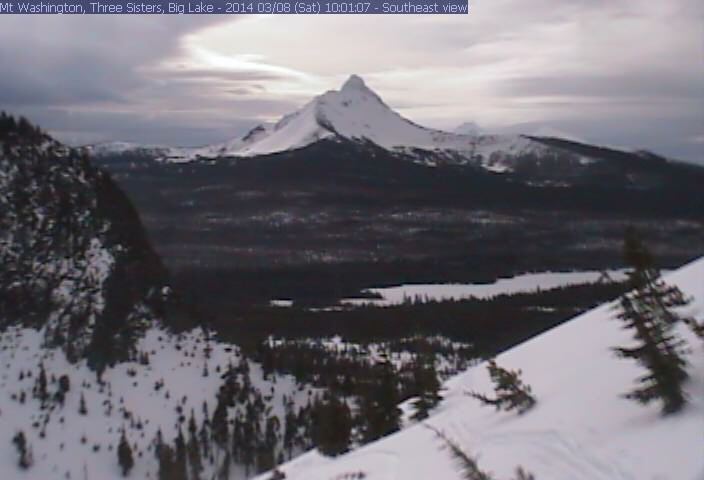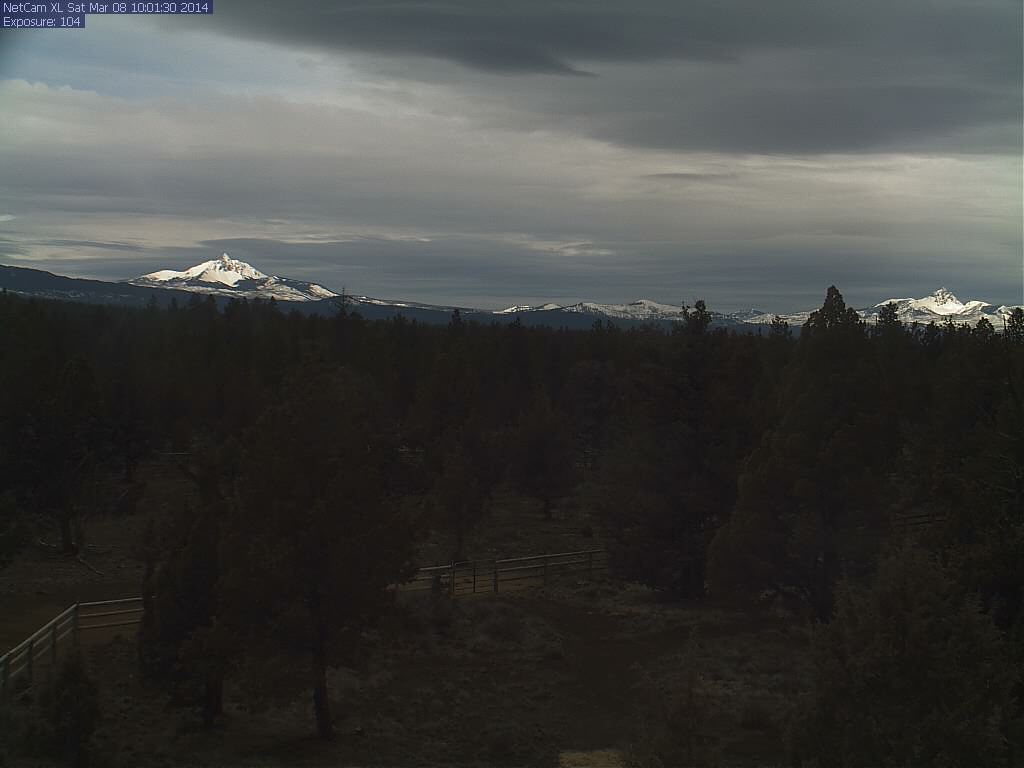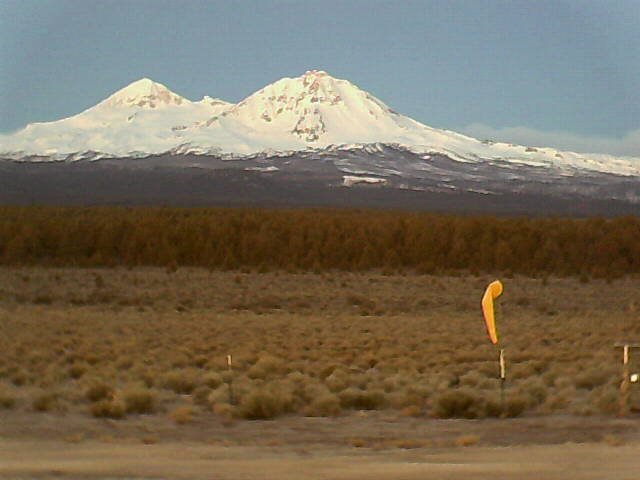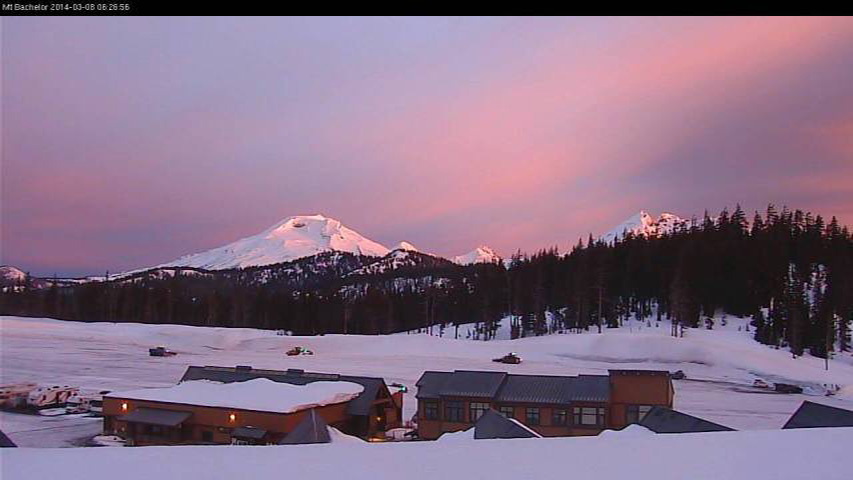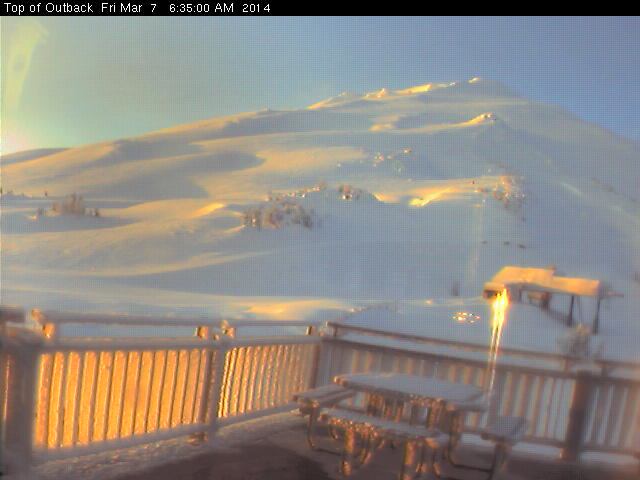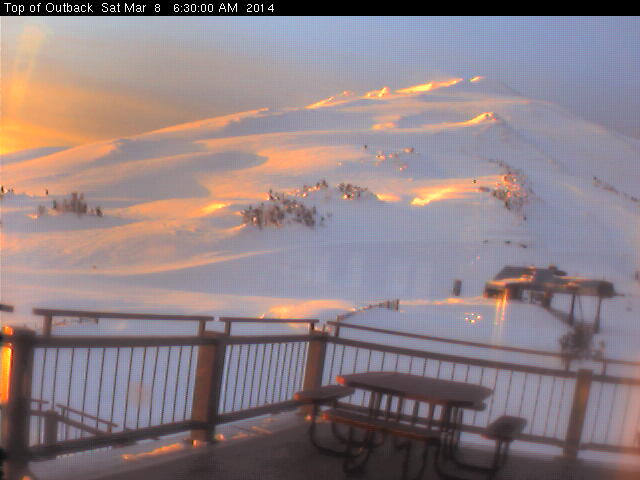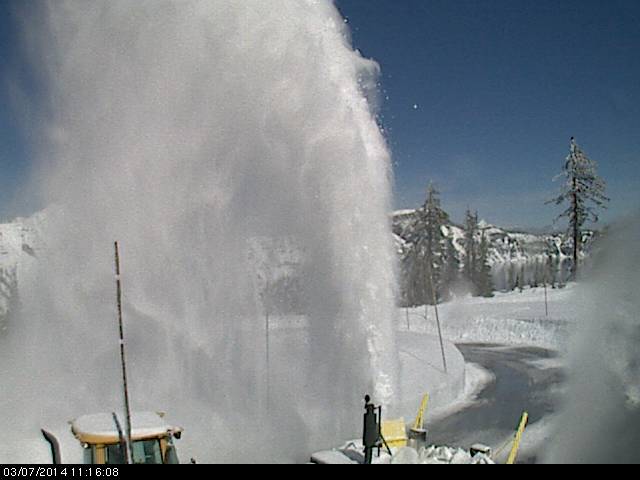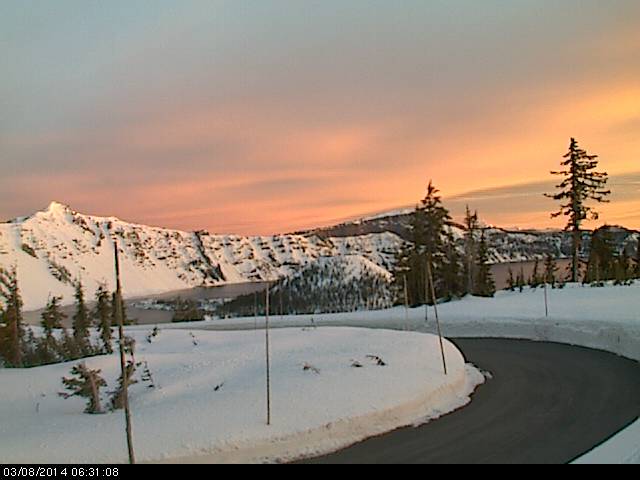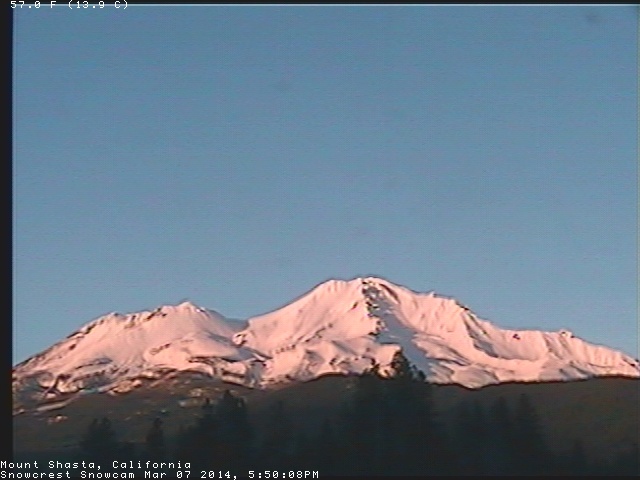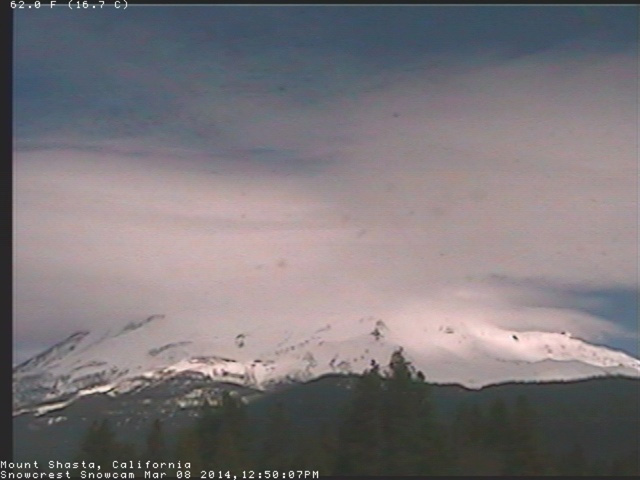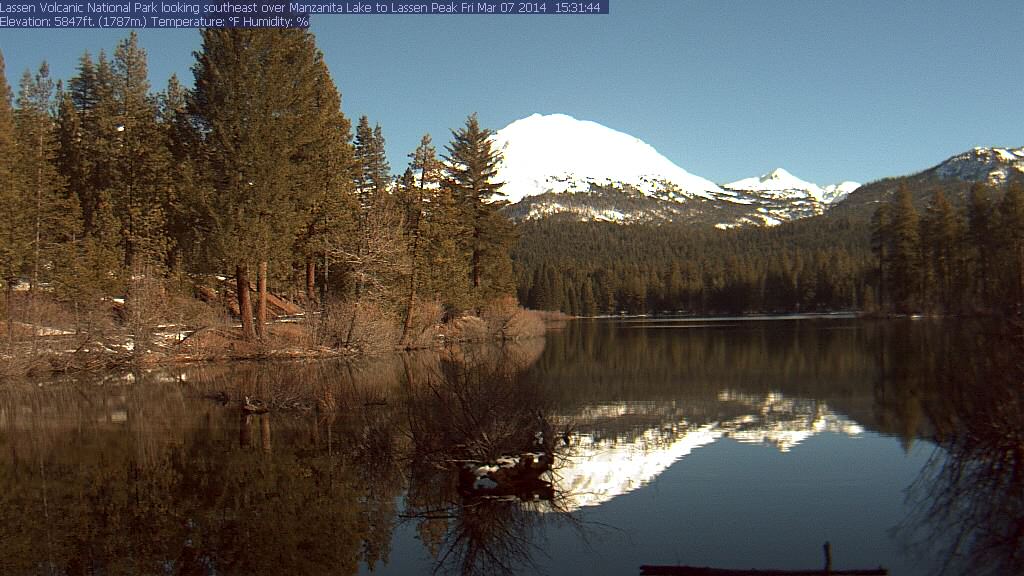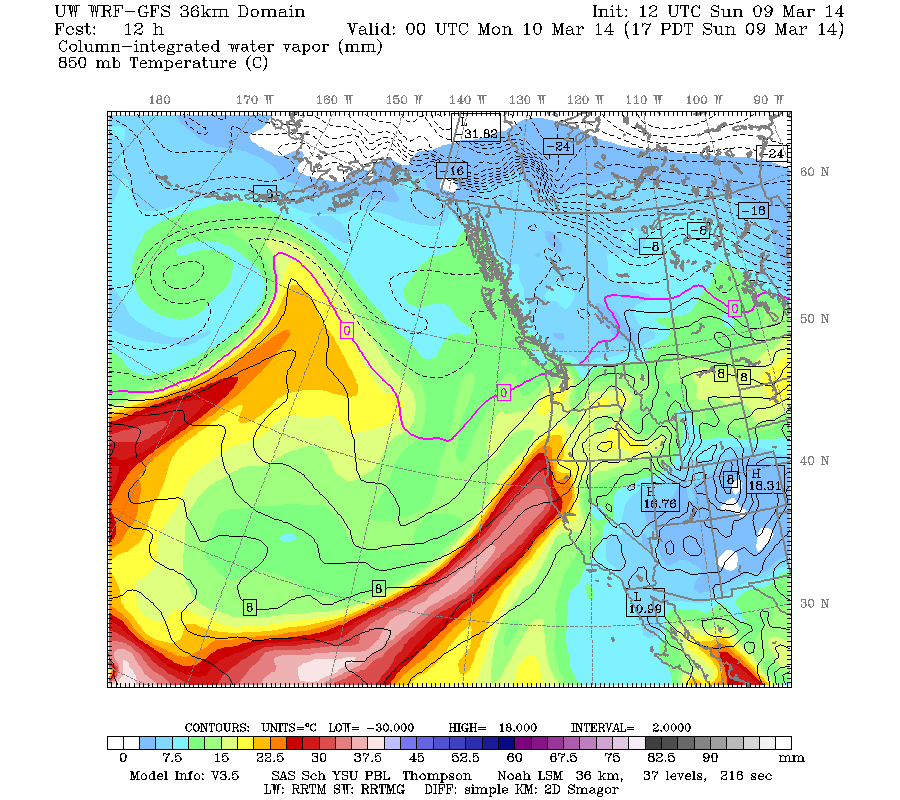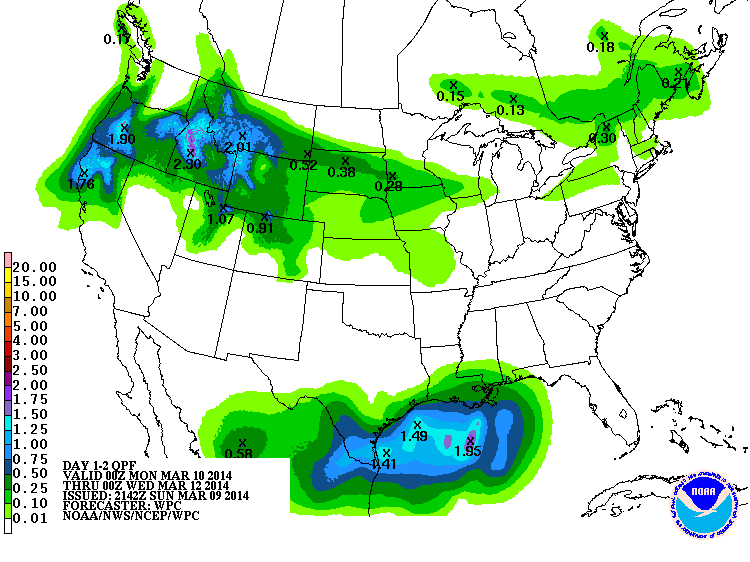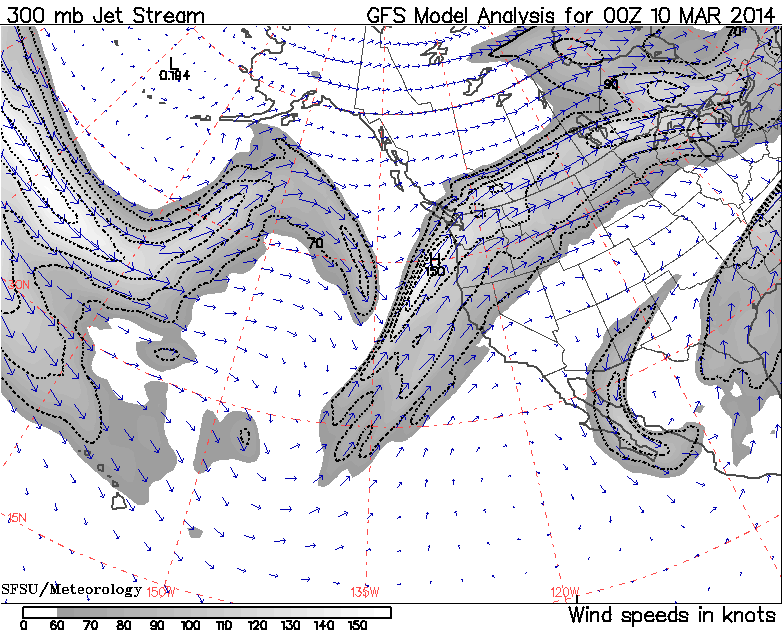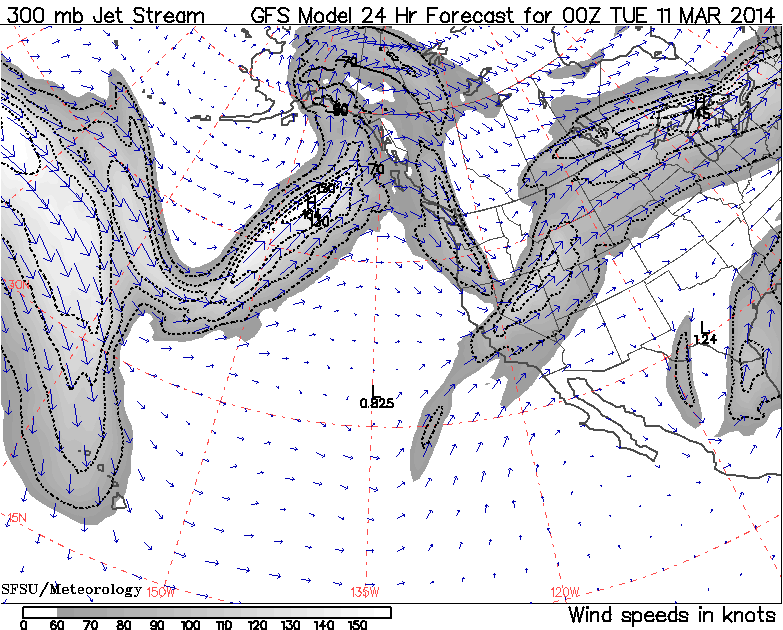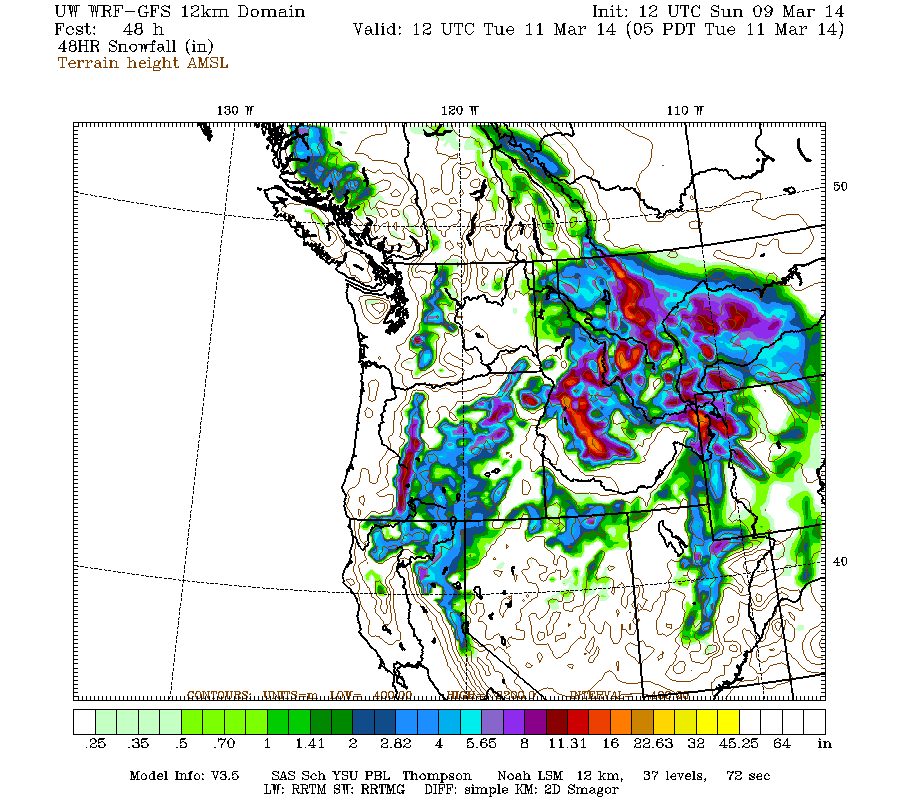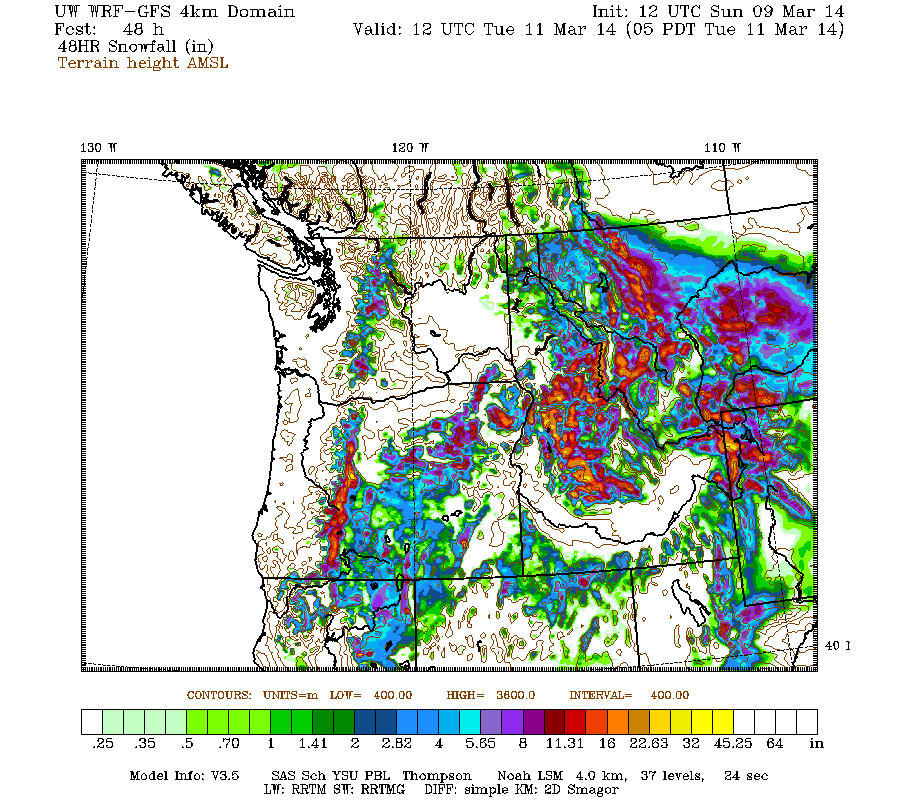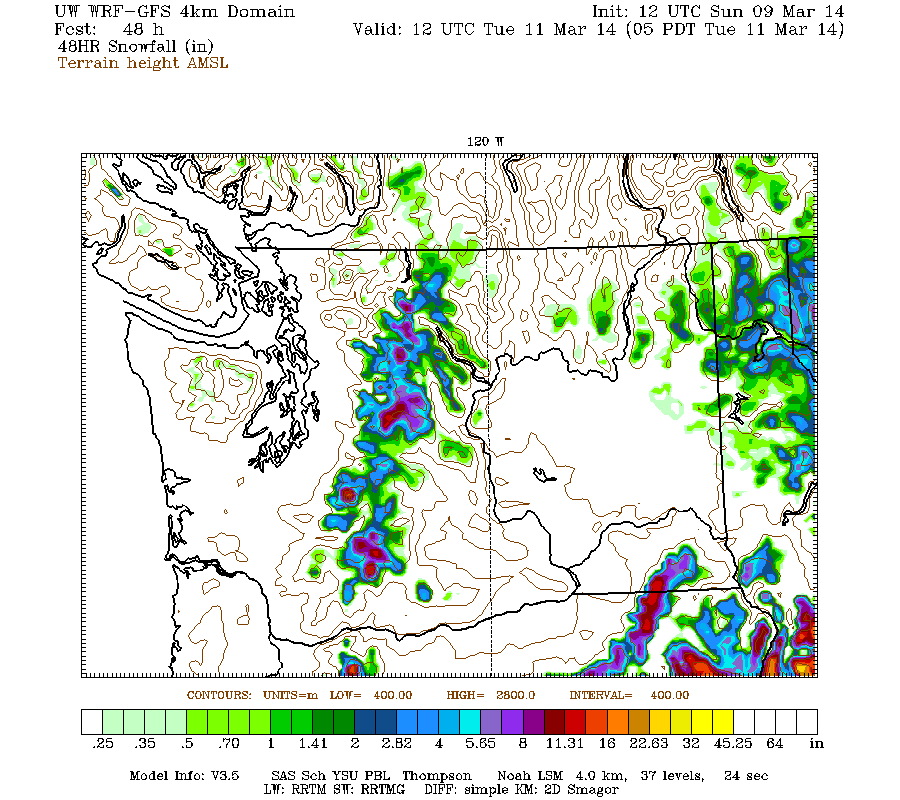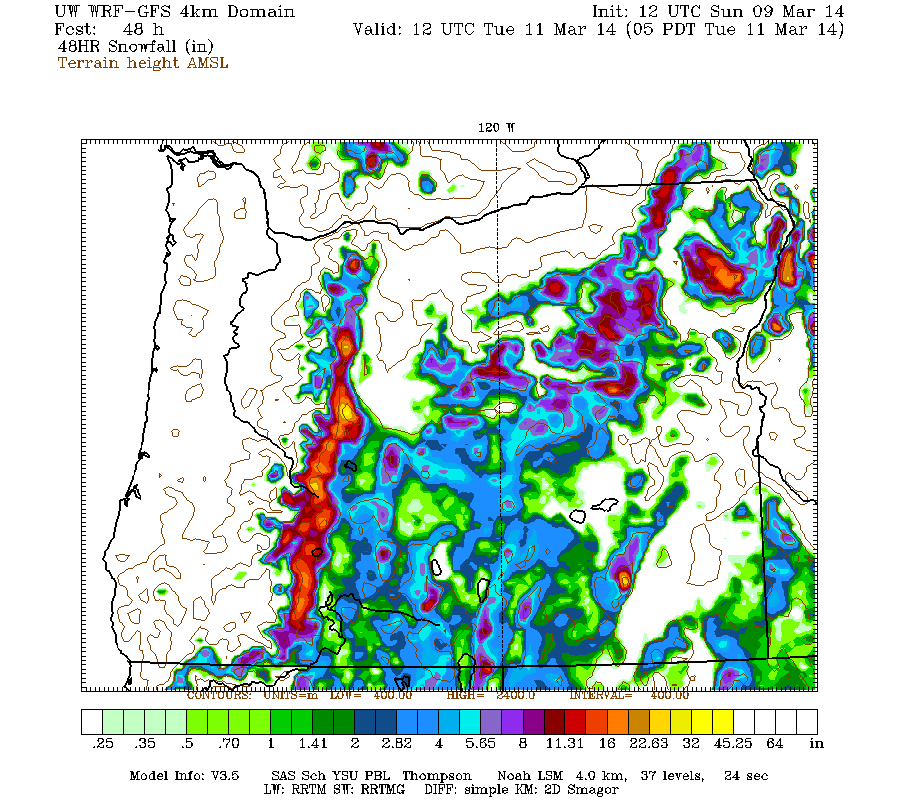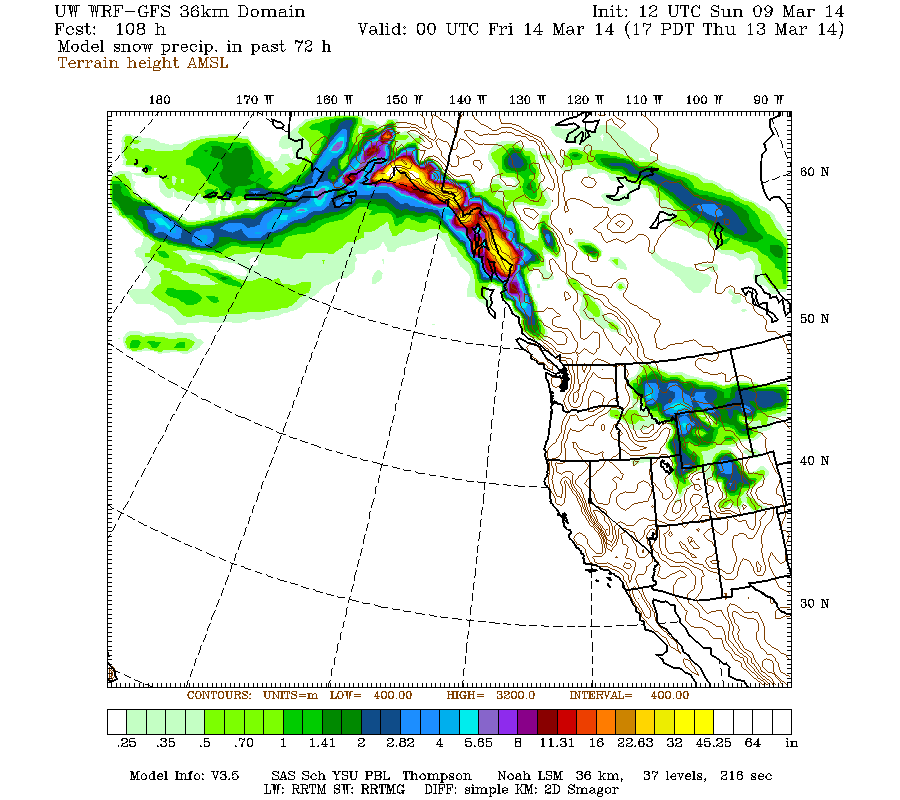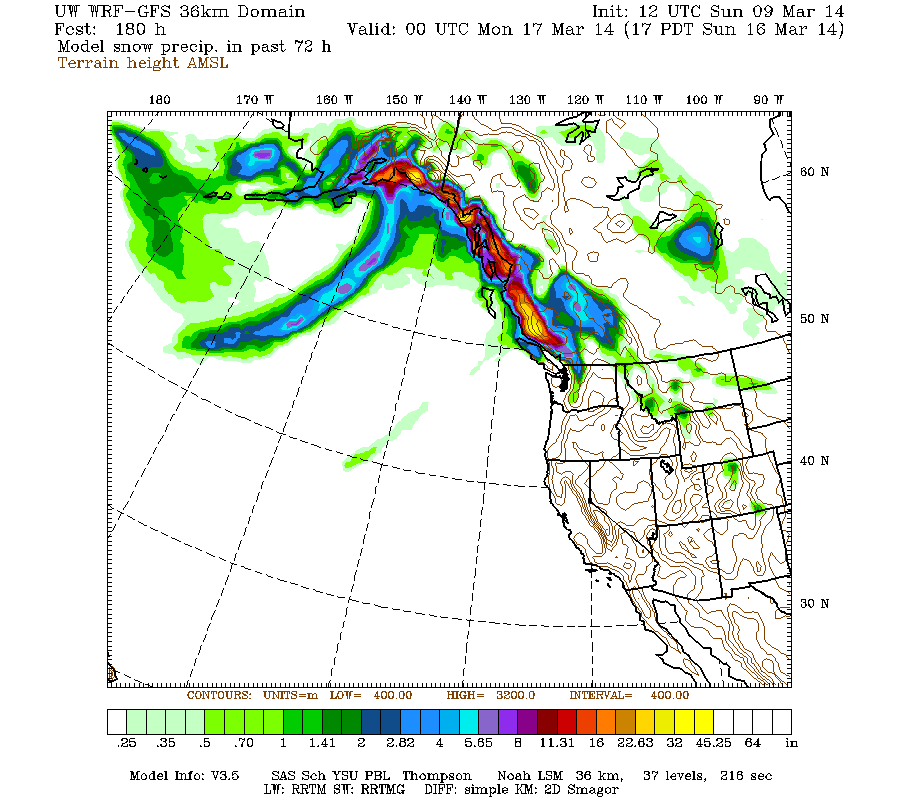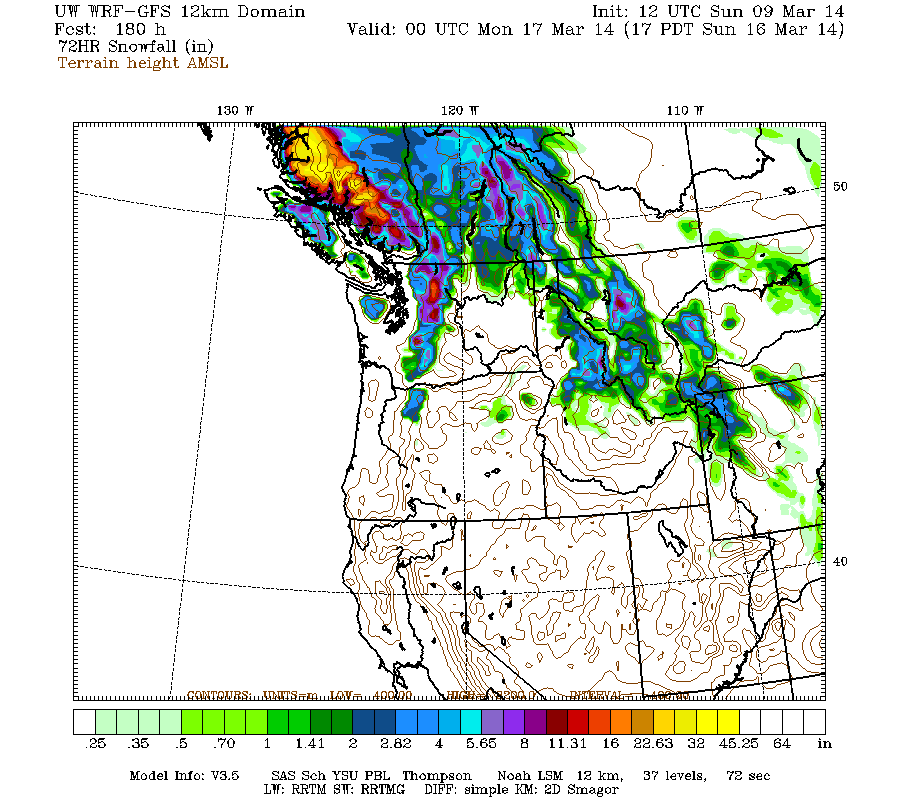- Posts: 635
- Thank you received: 0
New storm cycle with 4-8 ft snow Feb26-Mar10,2014!
- Amar Andalkar
- [andalkar]
-
 Topic Author
Topic Author
- Offline
- Premium Member
-

Title updated on 03/09/14 to reflect continuation of this storm cycle: New storm cycle with 4-8 ft snow Feb26-Mar10,2014![/size]
Next major storm cycle is underway, will bring another 4-8 ft of snow over the first week of March to Washington, Oregon, and northern California!
See also earlier threads:
First major storm cycle of the 2013-14 season brings 4-8 ft of snow (January 7-14, 2014)
Another major storm cycle brings 2-5 ft of snow (January 28-February 1, 2014)
HUGE storm cycle brings 4-14 ft of snow (February 6-25, 2014)
Wasn't really planning to start another thread about the current storm cycle, given that the last one continued on much longer than expected and took up way too much time and effort to write about (although my reasons for continuing to post updates and calculate total snowfall amounts were still the right ones: primarily for my own curiosity and intellectual interest). And after the last huge storm cycle, this season's snowpack is pretty much all set with near-normal snowdepths from southwestern BC through Washington and into northern Oregon, so there's just not as much interest in another storm cycle now that the winter of despair has unexpectedly and belatedly morphed into something resembling a "normal" winter. The earlier storm cycles were so interesting primarily because the 2013-14 season had begun so poorly, with near-record low snowpack throughout the West Coast into early January due to an extraordinarily persistent ridge of high pressure off the coast during the fall and early winter, and it seemed uncertain if it would ever snow significantly this season.
Plus the models had been all over the place regarding this new storm cycle (other than the first 3 days from February 26 to March 1 which would primarily hit California), with lots of variation run-to-run and little consistency in predicted snowfall for the Pacific Northwest, other than a vague trend of very wet and eventually very warm this week. But the model predictions have come more into line over the last couple of days, and it looks like this storm cycle will be very big in the Pacific Northwest, perhaps even bordering on huge once again with snowfall totals possibly exceeding 8-10 ft over the next week at some sites, especially at high elevations. So this storm cycle now looks a lot more interesting, and maybe it will be worth writing about this one too. And it's a very rainy afternoon, good writing weather right now.
This storm cycle actually began several days ago in the middle of last week, just a day or so after the last remnants of the previous storm cycle faded out. A new strong jet stream developed over the north-central Pacific, aimed eastward towards California and generating a pair of storm systems. The first came ashore on Wednesday February 26, bringing up to 1-2 ft of snowfall by Thursday morning from Mount Shasta south to the southern Sierra Nevada, and was followed quickly by a second much stronger system from Thursday night through Saturday, which brought another 1-4 ft of snowfall to the same region, with highest amounts at the southern end. The second system also brought 5-10" of rainfall to parts of the Transverse Ranges of southern California just north of LA producing severe flash flooding and numerous mudslides, with eventually 1-2 ft of snowfall at the SoCal ski areas as temps cooled by Saturday. The second system's strong deep low was amazing to see both in satellite images (there's practically an eye visible) and even in the modeled chart of sea level pressure (both images at 1pm Friday):
Total snowfall amounts for the two systems ranged from about 2-3 ft on Mount Shasta and Lassen Peak above 6000 ft, and through much of the Sierra Nevada above 7000 ft (some rain mixed in below that), with over 4.5 ft at Mammoth Mountain and even over 4 ft at June Mountain. June is located east of the Sierra crest just north of Mammoth and was extremely rain-shadowed during the previous huge storm cycle, with only 7" of snowfall while Mammoth got 32" and some Sierra sites got 6-7 ft, but the intense cyclonic circulation of these systems produced strong southerly and southeasterly flow which could wrap precip around to locations on the east side of the range.
The next system in the storm cycle moved ashore much farther north on Saturday March 1, primarily into Washington and Oregon but with a tail of lighter precip extending south into California through much of the Sierra. New snowfall amounts as of Sunday morning were around 3-12" for most of the Washington and northern Oregon Cascades. Lowland snowfall also occurred in two limited areas which received strong Arctic outflow from a very cold air mass over the interior to the northeast, in parts of northwest Washington and southwestern BC due to Fraser River outflow and also along the Columbia River Gorge, but the extent and amounts of lowland snowfall were far less than models had originally predicted several days ago (the predicted lowland snowfall had diminished in each subsequent model run).
[img]http://www.skimountaineer.com/TR/Images2014/Hood River Exit 64a_pid1863-2014Mar02-1047.jpg[/img]
Outside those areas exposed to the cold Arctic air mass and outflow, free air freezing levels on Sunday have generally ranged from 4000 ft in the northern Washington Cascades to 7000 ft in southern Oregon and northern California. Heavy snow and rain continued throughout the day Sunday, with new snowfall amounts of 6-14" during the day at many sites in Washington and northern Oregon, and a few inches extending south to the northern Sierra. Another system is expected to arrive early Monday, again primarily into Washington.
The NWS's GFS model and their Quantitative Precipitation Forecasts are showing up to 7-9" of precip over the next week for the mountains of southwestern BC, Washington, Oregon, and northern California, with less than 1" extending south into the Sierra Nevada. Here is total precipitation in inches predicted over the next 7 days through the afternoon of Sunday March 9:
The high-resolution UW WRF-GFS model is showing total snowfall amounts up to 4-8 ft or more over the next week for the mountains of Washington, Oregon, and northern California. Snowfall during the next 3 days from this morning through 4am Wednesday is predicted to be 3-6 ft over the Olympics, Washington Cascades, and volcanic peaks of the Oregon Cascades and California Cascades, with perhaps 1-2 ft extending into the northern Sierra Nevada:
Higher resolution version of that, showing the Pacific Northwest and also zoomed in on Washington and Oregon:
Maximum amounts of 4-6 ft (marked by white inside yellow) are shown over the west slopes of the Olympics, much of the north-central Washington Cascades, and the major volcanic peaks from Mount Rainier south to the Three Sisters region.
This loop shows how the model predictions for snowfall during the 3-day period through 4am Wednesday have evolved between 10 subsequent runs over the last 5 days, the D(model)/D(t). Lots of variation several days ago with radical changes run-to-run, but eventually settling into a more consistent picture the past couple of days:
www.atmos.washington.edu/~ovens/wxloop.c...2+v2014030512///+-st
Additional storm systems are predicted to arrive every 1-2 days through the end of next week, with perhaps the strongest system on Wednesday-Thursday. Additional snowfall during the subsequent 3 days ending 4am next Saturday is predicted to be another 2-4 ft over the Washington Cascades and southwestern BC, with 1-2 ft in the Oregon Cascades:
The D(model)/D(t) for that 3-day period has been fairly consistent thus far, although there have been only 4 model runs so far extending out to that period:
www.atmos.washington.edu/~ovens/wxloop.c...2+v2014030812///+-st
It looks like there will be two separate atmospheric river events during this week as part of this storm cycle, one arriving early Wednesday aimed at northern California and Oregon, and another arriving Friday aimed at Vancouver Island, eventually shifting southward towards Washington by Saturday and into Sunday:
So things will definitely be very wet if these predictions verify, and freezing levels will spike fairly high both times, but it also looks like there will be periods of more moderate freezing levels and very significant snowfall at most mountain locations before and after each big "Pineapple Express". Overall, this week appears to be very typical wintertime weather over the Pacific Northwest, which should be quite welcome given how atypical the weather has been for much of the 2013-14 season.
Please Log in or Create an account to join the conversation.
- elliotts
- [elliotts]
-

- Offline
- New Member
-

- Posts: 6
- Thank you received: 0
Please Log in or Create an account to join the conversation.
- Zap
- [Zap]
-

- Offline
- Platinum Member
-

- Posts: 1212
- Thank you received: 3
Please Log in or Create an account to join the conversation.
- Amar Andalkar
- [andalkar]
-
 Topic Author
Topic Author
- Offline
- Premium Member
-

- Posts: 635
- Thank you received: 0
with an additional 4-8 ft (or more) predicted over the next week for southwestern BC, Washington, and Oregon!
Decided to skip posting an update yesterday, to avoid burnout and also give the upcoming storm systems more time to develop and have that reflected in the model predictions. There just wasn't that much new to update yesterday, other than several feet of new snowfall in the Washington Cascades! And that has been continuing!
Model predictions for snowfall over the past 3 days have generally verified quite well. About 2-5 ft of snowfall has occurred over the Washington and BC Cascades during the 3+ days since snowfall began on the morning of Saturday March 1, with about 1-2 ft farther north in southwestern BC and also throughout the Oregon and California Cascades, with about 1 ft extending through the northern Sierra Nevada and a few inches as far south as Mammoth Mountain. Quite an excellent match to the predictions in the previous post! Maximum snowfall amounts over that period include 56" at Mount Baker Ski Area, 39" at Stevens Pass, 31" at Holden Village, 25" at Alpental base with 35" at the top, and 29" at Mount Rainier Paradise. Amazingly, the 31" at Holden Village is greater than their average snowfall for the entire month of March (27"), and comes right on the heels of their record-setting February (more info about that in this post ). Maximum precip amounts since Saturday morning have generally been in the 4-6" range from Mount Baker south to Mount Hood.
Free air freezing levels since Sunday have generally averaged from 4000 ft in the northern Washington Cascades to 7000 ft in southern Oregon and northern California (snow levels about 1000 ft lower), but areas exposed to the cold Arctic air mass east of the Cascades and to easterly outflow kept continued snowfall at far lower elevations into Monday afternoon, when pressure gradients eased and the strong southwesterly push of warm air overwhelmed the easterly flow. The large amounts of new snowfall at Snoqualmie atop a thick freezing-rain crust from the end of the last storm cycle, followed by a changeover to rain, produced very high avalanche hazard, causing a roughly 16-hour total shutdown of Interstate 90 on Monday March 3 from around midnight to 4pm, with large natural and explosive-triggered avalanches reportedly carrying trees and other debris onto the roadway.
Very interestingly, it wasn't just Snoqualmie and Stevens benefitting from the cold easterly flow this time. There was strong Arctic outflow through the Skagit River valley on Saturday and Sunday, producing heavy snowfall at elevations below 1000 ft with Ross Dam (1240 ft, MP 134 on SR 20) recording 17" of new snow, Diablo Dam (890 ft, MP 128 on SR 20) 20", and Newhalem (530 ft, MP 120 on SR 20) 14" through Monday morning before it all changed over to rain. The outflow was not sufficient to produce much snow at Concrete (200 ft, MP 88 on SR 20), which got only 0.5" of snow -- the Skagit valley is far wider and shallower at Concrete than at Newhalem, thus dispersing and dissipating the Arctic outflow by that point. All four sites got roughly the same precip of 3-4" as seen in the data here:
ROSS DAM (457185) 1240 ft DIABLO DAM (452157) 890 ft
Observed Daily Data: Mar 2014 Observed Daily Data: Mar 2014
Day MaxT MinT AvgT Pcpn Snow Snwg Day MaxT MinT AvgT Pcpn Snow Snwg
1 47 29 38.0 T T 8 1 50 31 40.5 T T 3
2 31 25 28.0 0.21 4.0 10 2 32 26 29.0 0.56 7.0 10
3 33 26 29.5 1.61 13.0 22 3 32 27 29.5 1.76 13.0 23
4 35 32 33.5 1.18 0.0 16 4 35 32 33.5 1.42 0.0 14
Smry 36.5 28.0 32.2 3.00 17.0 14.0 Smry 37.2 29.0 33.1 3.74 20.0 12.5
NEWHALEM (455840) 530 ft CONCRETE PPL FISH STN (451679) 200 ft
Observed Daily Data: Mar 2014 Observed Daily Data: Mar 2014
Day MaxT MinT AvgT Pcpn Snow Snwg Day MaxT MinT AvgT Pcpn Snow Snwg
1 53 34 43.5 0.00 0.0 0 1 52 37 44.5 T M M
2 35 27 31.0 0.67 7.0 7 2 39 31 35.0 0.34 0.5 1
3 31 28 29.5 1.50 7.0 12 3 37 32 34.5 1.45 0.0 0
4 34 31 32.5 1.50 0.0 8 4 41 36 38.5 1.40 0.0 0
Smry 38.2 30.0 34.1 3.67 14.0 6.8 Smry 42.2 34.0 38.1 3.19 0.5 0.3
[size=small]Deep snow at Diablo on Monday, as seen on the Seattle City Light webcams . Top of Diablo Dam (1220 ft) at left, Diablo Helistop (890 ft) at right. [/size]
Two days after the initial post, 4 subsequent runs of the UW WRF-GFS model at 12-hour intervals continue to predict very large precip and snowfall amounts, although the highest snowfall amounts will still occur only at higher elevations due to strong southwesterly flow during the wettest parts of the upcoming systems. The predicted amounts for both precip and snowfall have actually increased significantly for Washington, and the storm cycle now appears likely to continue through at least next Tuesday.
The NWS's GFS model and their Quantitative Precipitation Forecasts are showing up to 6-11" of additional precip over the next week for the mountains of southwestern BC, Washington, Oregon, and northern California, with about 1-2" extending south into the northern Sierra Nevada. Here is total precipitation in inches predicted over the next 7 days through the afternoon of Tuesday March 11:
The much-higher resolution and better handling of terrain in the UW model are predicting even greater precip amounts, with over 10" in spots during the next 3 days alone through 4pm Friday:
Maximum amounts of 10+" of precip (marked by white inside red) are shown over the west slopes of the Olympics, Mount Rainier, and Mount Saint Helens. Unfortunately the majority of that precip is going to fall as rain at most measurement sites, given that snow levels will rise to over 6000 ft in Washington and 7000 ft in Oregon during the day Wednesday and that night, but high elevation areas will get many feet of snow. By Thursday, the snow levels drop to around 4000-5000 ft, while heavy snowfall continues.
Snowfall during the next 3 days through 4pm Friday is predicted to be 2-7 ft over parts of southwestern BC, the Olympics, Washington Cascades, and volcanic peaks of the Oregon Cascades, with perhaps 1-3 ft extending as far south as Mount Shasta:
Higher resolution version of that, showing the Pacific Northwest and also zoomed in on Washington and Oregon:
Maximum snowfall amounts of 4-7 ft (marked by white inside yellow) are shown along the west slopes and volcanic peaks of the Washington Cascades and Olympics, plus the Three Sisters region in Oregon. The most intense period of snowfall is Thursday through early Friday, when even the 24-hour totals are predicted to exceed 4 ft on Mounts Baker, Rainier, and parts of the west slopes of the Olympics above about 6000 ft:
It won't be easy to see if such an extreme snowfall prediction actually verifies this time, since there are no measurement sites at high enough elevation in these areas. However, real 24-hour snowfall amounts in the 2-3 ft range are likely at the highest measurement sites such as Paradise.
This loop shows how the model predictions for snowfall during the 3-day period through 4pm Friday have evolved between 10 subsequent runs over the last 5 days, the D(model)/D(t). Very consistent in the overall picture, with ongoing variation in amounts:
www.atmos.washington.edu/~ovens/wxloop.c...2+v2014030800///+-st
There is expected to be a major lull in precipitation from Friday evening through Saturday for Oregon and Washington, as a transient weak ridge pushes the next incoming system northward towards the central BC coast and Vancouver Island. Eventually that system and its associated atmospheric river shift southward over Washington and Oregon by late Saturday. That weekend system is currently predicted to have even higher snow levels than the one on Wednesday (perhaps 7000-8000 ft), but not quite as much precip either. In any case, snowfall over the weekend will once again be limited to higher elevations only.
Another system on Monday into Tuesday may bring another shot of snowfall at more reasonable snow levels. Additional snowfall during the subsequent 3 days ending 5am (PDT already!) next Tuesday is predicted to be 2-4 ft over southwestern BC, with 1-2 ft in the Washington Cascades:
But that's a long way out, given that the evolution of the very strong system on Wednesday will have a significant effect on the development of the subsequent systems, and on upcoming model predictions.
Please Log in or Create an account to join the conversation.
- DendriteSupertramp
- [DendriteSupertramp]
-

- Offline
- New Member
-

- Posts: 25
- Thank you received: 0
I am looking at the potential for storms starting after 3/16.
MJO and PNA seem to take a dive into the good zones for Pacific NW storms starting around this time. Something to watch.
Any thoughts here?
Please Log in or Create an account to join the conversation.
- Amar Andalkar
- [andalkar]
-
 Topic Author
Topic Author
- Offline
- Premium Member
-

- Posts: 635
- Thank you received: 0
Pineapples are good......but not conducive to pow skiing.
I am looking at the potential for storms starting after 3/16.
MJO and PNA seem to take a dive into the good zones for Pacific NW storms starting around this time. Something to watch.
Any thoughts here?
I usually don't pay too much attention to predictions more than 7 days out, especially during a period of very active weather like the current one when there is so much to follow and try to keep up with right now. It's usually a waste of mental effort, at least for me, although it seems more worthwhile during periods of inactive weather while hoping for the next big storm system. I did take a quick look right now at the NWS Climate Prediction Center's Madden–Julian oscillation and Pacific / North American teleconnection pattern forecasts, but it's hard to give much weight to those predictions when even those making them acknowledge their severe limitations and lack of forecast skill. Sure, it looks "good" that the PNA is predicted to turn negative after mid-March, but even if that does come true, it has very limited correlation with the actual occurrence of snowfall or powder at any particular location in the Northwest (it is somewhat correlated with an increase in its likelihood).
And it also seems that not much has changed over the last decade in terms of improving forecasts over the weekly to seasonal (30-90 days) time scales like those for MJO or PNA (or longer time scales like ENSO), especially compared to the radical improvements in the accuracy of short-term (0-7 days) weather models like the UW WRF-GFS. Without which all of these storm cycle threads would simply not be possible to write. If looking for info about what's going to happen after mid-March, I'd put more faith on the extended GFS model which runs out to 16 days (so to March 21 now) and is currently predicting a change to northwesterly flow over this region by Wednesday March 19, with significant precip. But really, the 8-16 day GFS forecasts have little skill, they are still no better than climatology (and climatology has near-zero predictive value for heavy snowfall or powder since those are not "normal" or average events). There is little hope for improvement in forecasts 2 weeks out because the atmosphere is chaotic, and appears to be not predictable (in detail such as storm systems and snowfall) that far out. Sorry it sounds so hopeless, but that's how it is.
Please Log in or Create an account to join the conversation.
- Amar Andalkar
- [andalkar]
-
 Topic Author
Topic Author
- Offline
- Premium Member
-

- Posts: 635
- Thank you received: 0
with an additional 4-8 ft (or more) predicted over the next week for southwestern BC, Washington, and Oregon!
Just a brief update, during a nice lull between storm systems on Wednesday, following very heavy precip overnight into Wednesday morning, and before even heavier precip arrives on Wednesday evening. Significant snowfall overnight was only recorded at the highest measurement sites in the North Cascades and BC Cascades above 4000-5000 ft with about 6-12" new, but farther northwest in BC snowfall occurred down to below 1000 ft between Whistler and Squamish.
Another day later, and 2 more subsequent runs of the UW WRF-GFS model at 12-hour intervals continue to predict very large precip and snowfall amounts, although the highest snowfall amounts will still occur only at higher elevations due to strong southwesterly flow during the wettest parts of the upcoming systems. The storm cycle still appears likely to continue through next Tuesday.
The NWS's GFS model and their Quantitative Precipitation Forecasts are showing up to 5-9" of additional precip over the next week for the mountains of southwestern BC, Washington, Oregon, and northern California, with about 1-2" extending south into the northern Sierra Nevada. Here is total precipitation in inches predicted over the next 7 days through the afternoon of Wednesday March 12:
The next strong system arrives shortly on Wednesday evening, with its trailing cold front on early Thursday, and subsequent post-frontal showers should extend into Friday morning. Snow levels tonight are still expected to be 6000-7000 ft in most of the Washington and Oregon Cascades, but perhaps 5000 ft in the North Cascades and 4000 ft in southwestern BC. They are still expected to drop significantly by Thursday morning and even further by Thursday evening to around 3000-4000 ft.
Snowfall during the next 3 days through 4am Saturday is predicted to be 2-7 ft over southwestern BC and the Washington Cascades, around 1-4 ft over the Olympics and Oregon Cascades, with perhaps 1-3 ft extending as far south as Mount Shasta and 1 ft extending into the Sierra Nevada:
Higher resolution version of that, showing the Pacific Northwest and also zoomed in on Washington and Oregon:
Maximum snowfall amounts of 4-7 ft (marked by white inside yellow) are shown over parts of southwestern BC and the volcanic peaks of the Washington Cascades. The most intense period of snowfall is still expected Thursday through early Friday, and although 24-hour totals have diminished from yesterday's runs they are still predicted to be 2-3 ft on Mounts Baker, Rainier, Adams, and Saint Helens above about 5000-6000 ft.
This loop shows how the model predictions for snowfall during the 3-day period through 4am Saturday have evolved between 10 subsequent runs over the last 5 days, the D(model)/D(t). Very consistent in the overall picture, with ongoing variation in amounts:
www.atmos.washington.edu/~ovens/wxloop.c...2+v2014030812///+-st
There is still expected to be a major lull in precipitation from Friday evening through Saturday for Oregon and Washington, as a transient weak ridge pushes the next incoming system northward towards the central BC coast and Vancouver Island. Eventually that system and its associated atmospheric river shift southward over Washington and Oregon by late Saturday. That weekend system is currently predicted to have even higher snow levels than the one on Wednesday (perhaps 7000-8000 ft), but not quite as much precip either. In any case, snowfall over the weekend will once again be limited to higher elevations only.
Another system on Monday into Tuesday looks almost certain now, with more reasonable snow levels, and with snowfall now likely to extend through Oregon too. Additional snowfall during the subsequent 3 days ending 5am (PDT already!) next Tuesday is predicted to be 2-4 ft over southwestern BC, with 1-2 ft in the Washington and Oregon Cascades:
The D(model)/D(t) for that 3-day period has changed significantly despite only 4 model runs so far extending out to that period. Precipitation has shifted southward with each subsequent model run, greatly increasing predicted snowfall in Oregon:
www.atmos.washington.edu/~ovens/wxloop.c...2+v2014031112///+-st
Details of that system will likely continue to change as that period draws closer, as it is still 5-6 days out, near the limit of accurate numerical weather prediction, especially given that the evolution of the very strong system on Wednesday will have a significant effect on the development of the subsequent systems, and on upcoming model predictions.
Beyond Tuesday, it currently appears as though this storm cycle is likely to come to an end, with a moderate ridge of high pressure building over the West Coast during the middle of next week, and a new storm cycle developing with heavy precip and snowfall primarily over south-central and southeast Alaska. Here is a broad overview showing 24-hour snowfall through 5pm next Wednesday, with nothing over Washington/Oregon and 1-3 ft predicted in parts of Alaska:
Please Log in or Create an account to join the conversation.
- DendriteSupertramp
- [DendriteSupertramp]
-

- Offline
- New Member
-

- Posts: 25
- Thank you received: 0
I did take a quick look right now at the NWS Climate Prediction Center's Madden–Julian oscillation and Pacific / North American teleconnection pattern forecasts, but it's hard to give much weight to those predictions when even those making them acknowledge their severe limitations and lack of forecast skill. Sure, it looks "good" that the PNA is predicted to turn negative after mid-March, but even if that does come true, it has very limited correlation with the actual occurrence of snowfall or powder at any particular location in the Northwest (it is somewhat correlated with an increase in its likelihood).
... and is currently predicting a change to northwesterly flow over this region by Wednesday March 19, with significant precip.
Yes, the MJO has not been a factor this season....although I still watch it. The PNA is always a factor.
I still believe the GFS (even the loop forecasts in your posts) are not as valuable a predictor as the EURO.
BTW...I am only provoking weather discussion, in case you thought there was debate. You know; black swans, signals and noise.
Ed
Please Log in or Create an account to join the conversation.
- Amar Andalkar
- [andalkar]
-
 Topic Author
Topic Author
- Offline
- Premium Member
-

- Posts: 635
- Thank you received: 0
with an additional 3-8 ft predicted through Tuesday for southwestern BC, Washington, and Oregon!
Another update a day later, following 2 more subsequent runs of the UW WRF-GFS model at 12-hour intervals and very heavy precip overnight into Thursday morning from southwestern BC to the northern Sierra Nevada, at snow levels ranging from 5000 ft in BC to 6000 ft in Washington to 8000 ft in Oregon and over 9000 ft in California. The precip changed from rain to snow at higher-elevation sites by midnight, oddly enough earliest in Oregon and southern Washington as an upper trough (cold air aloft) arrived in that region first, while remaining warmest at higher elevations on the west slopes of the North Cascades into Thursday morning. The trailing surface cold front will pass through around midday Thursday, cooling temperatures substantially at all elevations and lowering snow levels to 4000 ft throughout the region from BC to Oregon, with about 5000 ft in northern California.
After all the rain, at least it is finally going to snow very heavily at reasonable elevations! Snowfall over the 24 hour period through 4am Friday is still expected to be 2-3 ft over the west slopes and volcanic peaks of the Olympics and Washington Cascades, with 1-2 in the Oregon Cascades:
The NWS's GFS model and their Quantitative Precipitation Forecasts are showing up to 4-6" of additional precip over the next week for the mountains of southwestern BC, Washington, Oregon, and northern California, with about 1" extending south into the northernmost Sierra Nevada. Here is total precipitation in inches predicted over the next 7 days through Thursday March 12, almost all of which will occur during the first 5 days through Tuesday morning along the West Coast:
There is still expected to be a major lull in precipitation from Friday afternoon through Saturday morning for Oregon and Washington, as a transient weak ridge pushes the next incoming system northward towards the central BC coast and Vancouver Island. Eventually that system and its associated atmospheric river shift southward over Washington and Oregon during the day Saturday. That weekend system is still predicted to have even higher snow levels than the one on Wednesday (perhaps 7000-8000 ft), but not quite as much precip either. In any case, snowfall over the weekend will once again be limited to higher elevations only.
The predictions for this weekend's atmospheric river event (the second of this storm cycle) have remained very consistent over subsequent model runs, compare this image for Saturday morning with the same prediction made 4 days earlier (last image of initial post above), and it looks almost identical:
Or just view the D(model)/D(t) for that to avoid scrolling back up:
www.atmos.washington.edu/~ovens/wxloop.c...v+v2014030812///+-st
Snowfall during the next 3 days through 5am Sunday (PDT already!) is predicted to be 2-6 ft over southwestern BC and the Washington Cascades, around 1-3 ft over the Olympics, with 1-2 ft in the Oregon Cascades and Mount Shasta, and less than 1 ft extending south to Lassen Peak. The majority of that will fall through Friday midday, except at high elevations in southwestern BC and Washington only which will get additional heavy snowfall Saturday and Sunday:
Higher resolution version of that, showing the Pacific Northwest and also zoomed in on Washington and Oregon:
This loop shows how the model predictions for snowfall during the 3-day period through 4am Sunday have evolved between 10 subsequent runs over the last 5 days, the D(model)/D(t). Very consistent in the overall picture, with ongoing variation in amounts and southern extent:
www.atmos.washington.edu/~ovens/wxloop.c...2+v2014030912///+-st
By Sunday evening, some significant snowfall may be occurring in the northern Washington Cascades as temperatures cool. Another system (or a pair of them in rapid succession) will arrive from Sunday evening through Monday, with snowfall ending on Tuesday morning. Snow levels continue to look much more reasonable for these final systems, and with snowfall still likely to extend through Oregon too. Additional snowfall during the subsequent 2 days ending 5am next Tuesday is predicted to be 1-2 ft over southwestern BC and the Washington, with about 1 ft in the Oregon Cascades and perhaps some snowfall extending south to the northern Sierra:
The D(model)/D(t) for that 2-day period has changed significantly despite only 6 model runs so far extending out to that period. Precipitation has shifted southward on later model runs, greatly increasing predicted snowfall in Oregon while reducing it over southwestern BC:
www.atmos.washington.edu/~ovens/wxloop.c...8+v2014031112///+-st
Details of those final systems will likely continue to change as that period draws closer, as it is still 4-5 days out, especially given that the evolution of the very strong system on Saturday will have a significant effect on the development of the subsequent systems, and on upcoming model predictions.
Beyond Tuesday, it still appears likely that this storm cycle will come to an end over the Northwest, with a moderate ridge of high pressure building over the West Coast during the middle of next week. A new storm cycle (or perhaps it's still linked to this one? hard to say for sure looking at jet stream and upper-level forecasts) is expected to develop on Monday with heavy precip and snowfall primarily over south-central and southeast Alaska for several days, and these amounts have increased substantially in more recent model runs. Here is a broad overview from the 36km resolution showing snowfall over the 3-day period through 5pm next Thursday, with nothing over Washington/Oregon (at this low resolution) and 3-6 ft predicted over parts of Alaska:
[size=small](This is actually model snow precip and not snowfall, but that distinction is unimportant for this image.)[/size]
South-central Alaska is also suffering from well-below-normal snowpack this season at elevations of interest for most skiing there and where all SNOTEL sites are located (below 3000-5000 ft). For example, snow depth atop Alyeska at 2750 ft is about half of normal now with less than 70", and snowpack at SNOTEL sites in that region is less than half of normal too:
So a major storm cycle with several feet of snowfall would be very welcome there. However, due to the huge atmospheric river event in mid-late January (during the Northwest's glorious 12-day sunny high-pressure period), which brought torrential rains up to 8000-10000 ft and produced a truly historic avalanche cycle near Valdez, it is likely that snowpack at higher elevations on the numerous icefields is already much closer to normal.
Please Log in or Create an account to join the conversation.
- BillK
- [bkent]
-

- Offline
- Junior Member
-

- Posts: 151
- Thank you received: 0
Please Log in or Create an account to join the conversation.
- elliotts
- [elliotts]
-

- Offline
- New Member
-

- Posts: 6
- Thank you received: 0
Please Log in or Create an account to join the conversation.
- DendriteSupertramp
- [DendriteSupertramp]
-

- Offline
- New Member
-

- Posts: 25
- Thank you received: 0
Let's talk about another Storm Cycle starting next weekend.(pattern shift?)
Also, why does the CPC seem to indicate mild conditions in the 8-14?
Again, the PNA and MJO are primed.
Please Log in or Create an account to join the conversation.
- Amar Andalkar
- [andalkar]
-
 Topic Author
Topic Author
- Offline
- Premium Member
-

- Posts: 635
- Thank you received: 0
[size=small]Enjoyed an awesome mostly-sunny day at Crystal Mountain Friday during a major lull between warm wet storm systems, yo-yoing 73,500 vert in 45 laps off Rainier Express and the gondola (and Forest Queen at day's end after the upper lifts had closed), my biggest ski day since 2010. About 4-8" of very dense "powder" atop a very uneven chunky surface left by previous days' skiers. Unfortunately I'd brought my alpine skis which were far too narrow (Volkl 7 24 Pro, 115-77-104) to enjoy those type of hidden minefield conditions, with potentially knee-twisting chunks lying just barely-buried and hidden everywhere, and any of my wider skis (88, 89, 106, or 125 mm underfoot) would have been a better choice for the morning. Made the best of it though to maximize my own enjoyment on the day, cautiously skied a few quick laps of the untracked powder to start the day before the increasing sunshine started cooking it, and then switched to lapping groomers at high speed after 9:30am. Shockingly there were no crowds or lines at all anytime (on a sunny powder day?!? although I once again avoided High Campbell), not even a morning rush this time and the gondola started loading at 8:45am. It was great to have a Friday that actually felt like a nice uncrowded midweek day the way it always used to be, not the overcrowded semi-Saturday that it often is the past few years given the increase in job-flexibility for so many people. Maybe most people think the ski season is over already (or never started)? It was not nearly as amazing conditions as my previous day at Crystal ( deep powder on February 19 during the previous huge storm cycle ), but made up for with glorious sunshine and minimal winds, easily the best day so far at Crystal during the current storm cycle. Anyway, first some photos and then on to the update later:[/size]
[size=small]Four views of Mount Rainier from atop Crystal Mountain, March 7 (iPhone photos, forgot real camera in the car):
The Mountain is already out at 9am. Incipient lenticular atop Rainier and full-fledged lee-wave cloud hovering off to its east, 11am.
Fleeting view through a swirl of clouds, 1pm. Clearest view of the day at 2:30pm, still tightly capped by a lenticular.[/size]
The strong and very wet system which moved into the Pacific Northwest on Wednesday evening and continued throughout Thursday finally moved out on Friday morning, leaving behind several inches of rain and eventually 3-15" of snow in the Washington and Oregon Cascades, significantly less than the forecasts and models had predicted. Almost the entire US West Coast cleared out during the major lull from Friday morning into Saturday morning between the two major atmospheric river events of this storm cycle, but southwestern BC never quite did. As usual, clearing was most complete farther south towards California.
While it was sunny to the south along the US West Coast, heavy precip and snowfall from the incoming storm and atmospheric river already started during the day Friday along the coast of BC and southeast Alaska. Mount Washington on Vancouver Island reported 3" new snow as of Saturday, and Whistler 2", but the real jackpot was much farther north with 14" new at Shames Mountain near Terrace, BC, and even 4" at Hudson Bay Mountain near Smithers, 70 miles farther inland from the coast. Lighter precip and snowfall extended into southeast Alaska with 2" new at Eaglecrest near Juneau.
Here is a selection of interesting webcam views showing weather conditions during the lull:
[size=small]Skies almost clearing by sunset Friday on Mount Baker and Twin Sisters Mountain, as seen on the visibility camera from Ferndale .[/size]
[size=small]Brief view of Mount Baker and Twin Sisters Mountain at sunrise Saturday before the next system arrived, as seen on the visibility camera from Ferndale .[/size]
[size=small]Morning sun on the Olympics Friday from Hurricane Ridge .[/size]
[size=small]Harbingers of the alien invasion (or maybe just the next incoming system): an entire fleet of alien spacecraft (or perhaps lenticulars) cruises the skies above the Olympics on Friday afternoon.[/size]
[size=small]Plowing deep snow at dawn on Friday in the parking lot at Paradise .[/size]
[size=small]Clouds obscured this side of the Mountain for most of Friday, but by late afternoon it was finally fully visible from Paradise .[/size]
[size=small]Sunset on the Tatoosh Range Friday seen from Paradise .[/size]
[size=small]Brief glow of dawn on the Mountain Saturday, but quickly obscured by the incoming storm.[/size]
[size=small]Mount Adams looking ready to ski on Friday morning, as seen from Trout Lake .[/size]
[size=small]Last light on Mount Hood Friday, as seen from Timberline .[/size]
[size=small]First light on Mount Hood Saturday, as seen from Timberline .[/size]
[size=small]But the storm arrives shortly on Mount Hood Saturday morning, as seen from Timberline .[/size]
[size=small]Sunset glow on Mount Jefferson Friday, looking south from Timberline Lodge on Mount Hood .[/size]
[size=small]Sunrise glow on Mount Jefferson Saturday, looking south from Timberline Lodge on Mount Hood .[/size]
[size=small]Lenticular growing above Mount Jefferson on Saturday morning behind Three Fingered Jack at right, looking NE from Hoodoo Butte .[/size]
[size=small]A hole in the cloud deck above Mount Washington on Saturday morning, looking SE from Hoodoo Butte .[/size]
[size=small]Sunlight shining from above on Mount Washington (left) and Three Fingered Jack (right) on Saturday morning, at the same time as the previous 2 images but from the opposite side at Lucas ranch between Bend and Sisters.[/size]
[size=small]Sunrise on North Sister and Middle Sister Friday, as seen on the Cascade Flyers webcam between Bend and Sisters (2014-03-07 6:20am).[/size]
[size=small]Sunrise glow on South Sister, Middle Sister, North Sister, and Broken Top (left to right) Saturday as seen from Mount Bachelor .[/size]
[size=small]Sunrise glow on Mount Bachelor Friday as seen from Pine Marten Lodge at 7700 ft.[/size]
[size=small]Sunrise glow on Mount Bachelor Saturday as seen from Pine Marten Lodge at 7700 ft, same glow but less rime.[/size]
[size=small]Sunrise glow on Mount Bachelor Saturday as seen from West Village at 6300 ft.[/size]
[size=small]Snow blower dealing with deep snow on Friday at Crater Lake .[/size]
[size=small]Sunrise glow on Saturday at Crater Lake .[/size]
[size=small]Mount Shasta at sunset Friday, as seen on the SnowCrest webcam .[/size]
[size=small]Mount Shasta capped by an awesome jumble of lenticular clouds midday Saturday as the next storm approaches, as seen on the SnowCrest webcam .[/size]
[size=small]Lassen Peak glowing far too brightly but reflected nicely in the Manzanita Lake webcam on Friday afternoon.[/size]
[size=small]Sunrise glow on Mammoth Mountain Saturday, as seen on the Caltrans webcam .[/size]
Update #4 to be posted shortly...
Please Log in or Create an account to join the conversation.
- Amar Andalkar
- [andalkar]
-
 Topic Author
Topic Author
- Offline
- Premium Member
-

- Posts: 635
- Thank you received: 0
with an additional 0.5-2 ft predicted through late Monday for southern Washington, Oregon, and northern California!
[size=small]Never did finish the partially-written update (referred to above) enough to post it by Saturday evening as planned, so I skipped it and just rolled it all into today's update:[/size]
The final days of this storm cycle have arrived, following the second of two atmospheric river events which brought heavy precipitation and high-elevation snowfall from southeastern Alaska to northern California starting on Friday and lasting through Sunday. Snow levels during the heaviest precip from Saturday midday into Sunday morning ranged from about 4000 ft in parts of southwestern BC and Vancouver Island (if far enough northwest), to 5000-6000 ft in the Olympics, BC Cascades, and North Cascades, 7000-8000 ft in the southern Washington and northern Oregon Cascades, and 9000 ft for most of the Oregon Cascades and northern California. The last system from tonight through Monday evening will bring additional significant precip and snowfall at much lower snow levels, but primarily for Oregon and northern California with only a limited amount extending into southern Washington, followed by several days of high pressure and sunshine from Tuesday through Thursday.
Despite pouring rain at most locations, very heavy snowfall was recorded during the second atmospheric river at sites far enough northwest and high enough up, with 24-hour totals through midday Sunday of 1-2 ft at some measurement sites. The largest amounts include 12" new at Shames Mountain near Terrace, BC, 23" at Mount Washington on Vancouver Island (4500 ft), over 20" at the Squamish River BCRFC site west of Whistler (which stayed all snow despite its modest 4500 ft elevation), 15" at Whistler Mountain (5400 ft), about 15" at the Chilliwack River BCRFC site (5300 ft in the BC Cascades just north of the US border near Mount Baker), over 18" at Brown Top SNOTEL (5800 ft near Mount Redoubt in the North Cascades), and about 16" at Harts Pass SNOTEL (6500 ft). Very little snowfall was recorded at any measurement sites south of the North Cascades, as all sites farther south were below the snow level.
Precip amounts through midday Sunday were generally in the 2-4" range at most mountain sites from southwestern BC to southern Oregon, with a sharp drop-off to about 1" or less in northern California. However, heavy precip continues on Sunday evening in northern California and southern Oregon, as the atmospheric river has moved steadily southward over the past 2 days, and although now much weaker is aimed directly at that region as of 5pm Sunday:
The NWS's GFS model and their Quantitative Precipitation Forecasts are showing up to 1-2" of additional precip during this storm cycle for the mountains of Oregon and northern California, with much less extending north into Washington. Here is the total precipitation in inches predicted over the next 2 days through Tuesday:
As the atmospheric river fades away, there will be a brief change to northwesterly flow which will only last through Monday night (and eventually northerly on Tuesday), as seen in the jet stream forecasts . Here is the current strong southwesterly jet as of 5pm Sunday, and the complete change predicted 24 hours later by 5pm Monday:
Also visible in the second image is another strong new jet stream that will be aimed directly into south-central and southeast Alaska by Monday, lasting through midweek (more on that below).
The incoming northwesterly flow is expected to lower snow levels greatly by Monday, and produce heavy snowfall where it interacts with remnants of the southwesterly moisture plume. Snowfall during the 2-day period through 5am Tuesday is predicted to be 1-2 ft in the Oregon Cascades, with less than 1 ft in the southern Washington Cascades and California Cascades, and a few inches extending into the northern Sierra Nevada:
Higher resolution version of that, showing the Pacific Northwest and also zoomed in on Washington and Oregon:
Maximum snowfall amounts of about 2 ft are shown over several of the volcanic peaks of the Oregon Cascades, with perhaps 2-3 ft in the Three Sisters region.
This loop shows how the model predictions for snowfall during the 2-day period through 5am Tuesday have evolved between 12 subsequent runs over the last 6 days, the D(model)/D(t). Lots of major changes early on, but eventually settling into a somewhat more consistent picture over the past 2-3 days, but with ongoing variation in amounts and geographic extent:
www.atmos.washington.edu/~ovens/wxloop.c...8+v2014031112///+-st
Based on that large degree of run-to-run variation, the snowfall amounts from the remaining system remain quite uncertain.
What does not appear to be uncertain is that high pressure will build on Tuesday, bringing clear skies throughout the US West Coast, although with lingering clouds in southwestern BC. Meanwhile, a very strong low pressure system has already developed Sunday south of the Aleutians and will moved eastward into the Gulf of Alaska on Monday. A series of additional storm systems will develop in the wake of that one, bringing very heavy precip and snowfall to south-central and southeast Alaska for several days through the end of the week. Here is a broad overview from the 36km resolution showing snowfall over the 3-day period through 5pm next Thursday, with 3-6 ft still predicted over most of the coastal mountains of south-central and southeast Alaska (compare with the same image in Update #3 above, looks very similar):
Or just view the D(model)/D(t) for that to avoid scrolling back up, very consistent throughout 7 model runs over the past 4 days:
www.atmos.washington.edu/~ovens/wxloop.c...2+v2014031400///+-st
Here is predicted snowfall over the subsequent 3-day period through 5pm next Sunday, with another 2-3 ft for Alaska and now also for most of the BC coast, with just a bit extending south into Washington:
[size=small](The previous 2 images are actually model snow precip and not snowfall, but that distinction is unimportant here.)[/size]
The higher-resolution 12km version of that shows up to 1 ft of snowfall in the Washington Cascades, with one system predicted for Friday and another stronger system for next Sunday:
But that's still 5-7 days out, near the limit of accurate numerical weather prediction, so those storms are no sure thing quite yet. And all of that is still arriving on primarily southwest flow, wrapping around the strong lows in the Gulf of Alaska, but with northwesterly flow temporarily over the region on Friday as the flow moves around the northern end of high pressure over the northeast Pacific (see the jet stream forecasts again). Perhaps not the perfect powder pattern that some people are pining for, but perhaps enough.
The extended GFS model out to 384 hours (16 days) shows no evidence of a lengthy change to northwest flow anymore, although it produces additional storm systems during the 8-16 day period. This is the predicted 24-hour precip and sea level pressure isobars, click "Loop All" to see all the graphics (3 hour intervals up to 192 hours, 12 hour intervals beyond that):
GFS, North Pacific, 03/09/2014 18UTC, precip_p24
Please Log in or Create an account to join the conversation.
- DendriteSupertramp
- [DendriteSupertramp]
-

- Offline
- New Member
-

- Posts: 25
- Thank you received: 0
snowbrains.com/winter-coming-end-tahoewill-just-beginning/
Ed
Please Log in or Create an account to join the conversation.

